NEOMI & MARIO
The Quiet Architects of Goa’s Grooming Revolution
IN FOCUS
STRENGTHENING THE BACKBONE OF COASTAL GOA
Government Schemes Supporting Fishermen
SPECIAL STORY
TROUBLE IN TAXI PARADISE
Goa’s Tug of War Over App-Based Cabs
FEATURE
GOA'S SOCIAL SHIFT
A Deep Dive Into the Aestheticisation of a Destination

































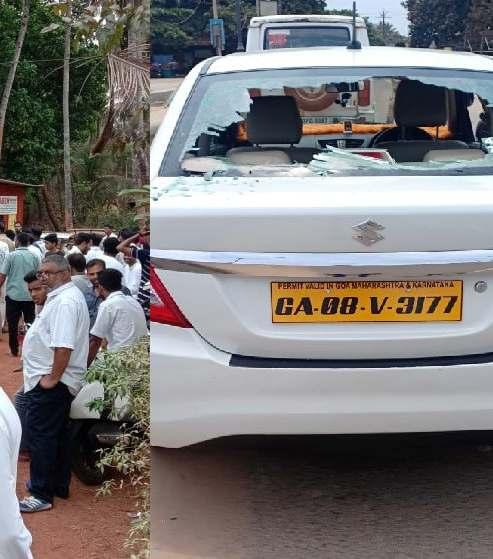




COPPERLEAF: WHERE CORPORATE SUCCESS MEETS CULINARY EXCELLENCE
EDC PAYS RS. 521.54 LAKHS TO GOVERNMENT, REPORTS STRONG FINANCIAL PERFORMANCE
MANIPAL HOSPITAL GOA SAVES WOMAN WITH BREAKTHROUGH BRAIN SURGERY
GCCI WELCOMES GOA TRANSPORT AGGREGATOR GUIDELINES 2025 AS A MILESTONE IN MOBILITY
BIMA SAKHI YOJANA GOA'S BOLD LEAP TOWARDS WOMEN-LED FINANCIAL EMPOWERMENT
GOA TOURISM TO HOST GRAND SÃO JOÃO BOAT FESTIVAL ON JUNE 24
22 SPECIAL STORY
TROUBLE IN TAXI PARADISE
Goa's Tug of War Over App-Based Cabs
STRENGTHENING THE BACKBONE OF COASTAL GOA
Government Schemes Supporting Fishermen
In its unwavering mission to support Goa’s economic development, the Economic Development Corporation (EDC) of Goa continues to introduce forward-looking financial solutions that empower businesses. Among its noteworthy offerings is the Mortgage Loan..
WHERE GREEN MEETS GRANDEUR A REGAL
AT UK 27 THE FERN, BELAGAVI
CITY LIGHTS, QUIET NIGHTS A LUXE STAYCATION AT HOLIDAY INN GURGAON
38 SUSTAINABLE GOA
GOA MARKETS GO SUSTAINABLE HOW GREEN PRACTICES ARE TAKING ROOT IN LOCAL COMMERCE
GREEN DIALOGUE 2025 WHEN PURPOSE SPOKE LOUDER THAN WORDS
52 BUSINESS BUZZ
GOA AIMS TO BECOME INDIA'S NEXT INNOVATION HUB WITH AI AND TECH CENTRES
GOA BASED KINECO SIGNS LANDMARK DEAL WITH EUROPEAN AEROSPACE LEADER
GOA'S FESTIVALS AND CONCERTS DRAW INTERNATIONAL CROWDS AND BUSINESS
COLUMNS
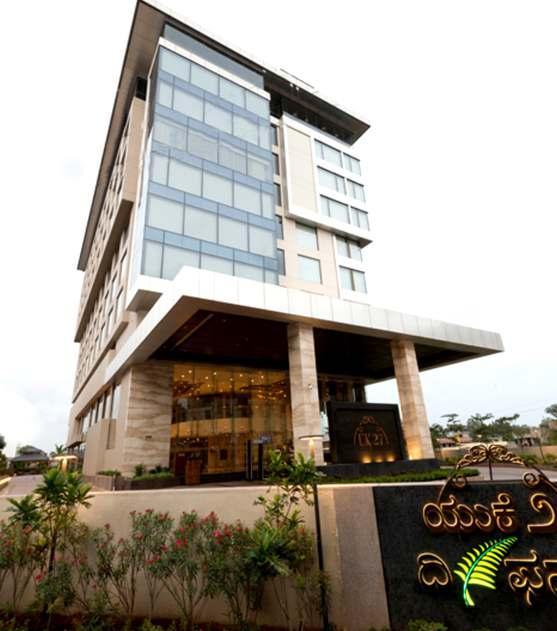
56 FINANCE
54 FITNESS ADDITIONAL INFORMATION IN ITR HOW TO STRENGTHEN YOUR JOINTS?
58 REAL ESTATE LIFE'S A BEACH… OR IS IT?
60 HEALTH DEBUNKING MYTHS ABOUT SMARTPHONES AND BRAIN TUMOURS










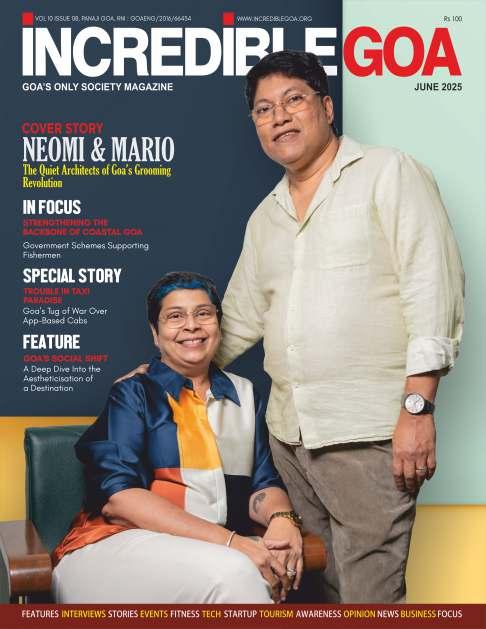
EDITOR & PUBLISHER
Rajesh Ghadge rajesh@rajeshghadge.com
FINANCE &ADMIN
Rajeshree Naik Ghadge info@incrediblegoa.org
CONTENT WRITERS
Aditi Malhotra Aakash Ghadge
Gauri Ghadge
write@goaprism.com
The Season of Green and Growth
As the monsoon clouds sweep over Goa, they bring with them not just rain but a refreshing transformation in the state’s tourism landscape. The season marks a major shift from the beaches to the hinterlands, from sunbathing to waterfall trekking, and from parties to vibrant, cultural festivals. At the heart of this transformation lies monsoon tourism, a concept that has grown in stature and significance, especially in the post-COVID era.
Gone are the days when Goa was solely seen as a party destination for foreign travelers. With international footfall taking a dip after the pandemic, local tourism found its footing, and the Goa Tourism Department responded with strategic foresight, promoting hinterland experiences like spice plantation tours, monsoon treks, white-water rafting, and cultural immersions that showcase the true soul of Goa.


LAYOUTS & DESIGN
GPDM - A MEDIA COMPANY
info@gpdm.in
SALES & MARKETING Team Incredible Goa sales@incrediblegoa.org CONTRIBUTORS
Norbert D’Souza CA Gaurav Kenkre
Prashant Kalra
Niharika Sachdeva Dr Omkar Churi Saloni Pai
write@incrediblegoa.org
CIRCULATIONS
Aakash Ghadge subscribe@incrediblegoa.org
PHOTOGRAPHY
TEAM IG Info@incrediblegoa.org
STOCK IMAGES www.freepik.com
South Goa : FIIRE Business Incubator, Fatorda - Goa. 403602 Call: +91 89990 85172 / 96651 83739 Email: info@gpdm.in
The monsoon season kicks off with the spirited celebration of Sao Joao on June 24th, a festival where people leap into wells, sing traditional songs, and wear floral crowns in honor of St. John the Baptist. This is followed by Sangod on June 29th and Chikal Kalo in July, each with its own joyous customs that light up villages and towns with life and color.
At Incredible Goa, we continue our mission to highlight this seasonal magic from cascading waterfalls and lush green ghats to the flavors of traditional Goan cuisine across our print and digital platforms.
This issue brings you a wide array of engaging stories, beginning with the inspirational journey of Neomi and Mario, the trailblazing duo who revolutionized the grooming industry in Goa. Their contribution has redefined personal care and set new benchmarks in style and wellness across the state. We also take a closer look at the ongoing unrest in Goa’s taxi sector, as app-based cab services disrupt traditional cabbie businesses In our Focus section, we delve into the government’s welfare schemes for Goa’s fishing community, vital for a sustainable coastal economy. Our Feature Story dissects the growing influence of social media on lifestyle, tourism, and youth culture in the state.
As always, we bring you deep insights across Hospitality, Sustainability, Business, Entertainment, Awareness, Startups, Tech, and Sports, along with specialist columns on Fitness, Health, Real Estate, and Finance. Till next time, happy reading.
Rajesh Ghadge Editor
Rajesh’s long journey began with an early realization of his writing skills and nearly a superhuman power of vivid imagination; which together led to the birth of a successful media portal. His never-ending spree of learning has made him efficient in varied fields like coding, designing and also marketing. He fuels himself with continuous reading being a history fanatic and bouts of music and movies. Acting as a one-man army he prizes work over almost everything.
rajeshghadgeofficial
rajeshghadgeofficial
rajeshghadge
www.rajeshghadge.com
rajesh@rajeshghadge

COPPERLEAF: WHERE CORPORATE SUCCESS MEETS CULINARY EXCELLENCE
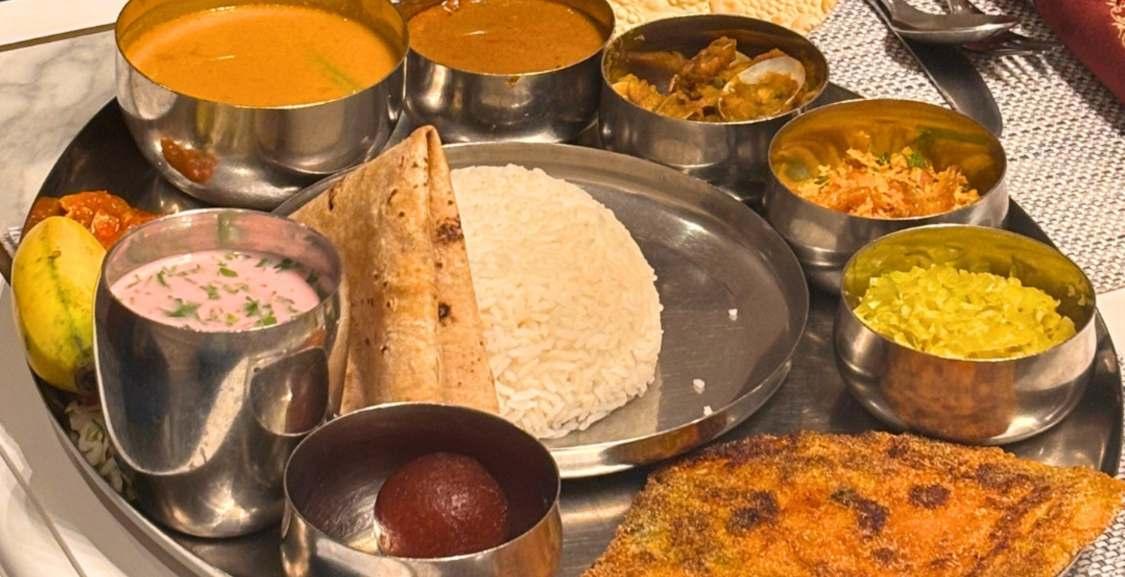
In the heart of Goa's dining scene, Copperleaf has carved out a reputation as one of the state's m o s t b e l o v e d f i n e - d i n i n g destinations. With elegant outlets
i n P o r v o r i m a n d P a n a j i , Copperleaf is celebrated for its exquisite offerings in Indian, Goan, Tandoori, and Chinese cuisine served in a refined setting that combines tasteful interiors with warm hospitality. But beyond the exceptional food and ambience, Copperleaf is redefining what it means to dine
with purpose. The restaurant has introduced thoughtful initiatives that honour the achievements and milestones of working professionals, making every celebration feel even more meaningful.
Corporate Discount Program: Rewarding Success with Taste
L a u n c h e d i n 2 0 2 2 , t h e
Copperleaf Corporate Discount Program was designed to offer exclusive benefits to employees of partnered organizations Whether it's a dine-in experience,
a takeaway order, or a home delivery, the program ensures that professionals and their families e n j o y d e l i c i o u s m e a l s a t privileged rates making every gathering a little more special. Today, the Copperleaf corporate network includes an impressive roster of companies across industries such as finance, IT, pharmaceuticals, banking, logistics, and hospitality. Some notable partners include State Bank of India, ICICI Bank, GMR, NABARD, Sanofi, Vedanta, Siemens, Unichem, RBI, BNI, Open Destinations, and many more.
Going Beyond the Table
What makes Copperleaf truly stand out is its commitment to gratitude and connection The restaurant also offers: Armed Forces Discount, in salute to our brave servicemen and women
Copperleaf Elite Club Loyalty Program, for regular guests Professional Loyalty Program, for
EDC PAYS RS. 521.54 LAKHS TO GOVERNMENT, REPORTS STRONG

EDC Limited, Goa's premier development finance institution, handed over cheques totaling Rs. 521.54 lakhs to the Government of Goa in a formal event attended by Chief Minister Dr Pramod Sawant and Rajya Sabha MP Shri Sadanand Shet Tanavade. The cheques were presented by Shri B S Pai Angle, Managing Director, and Shri B.S. Borkar, Joint Managing Director, EDC Ltd. The amount includes Rs. 86.20 lakhs paid as dividend for the
financial year 2023–24 and Rs. 435.34 lakhs towards interest on net deposits for land acquisition, which were made by various government departments and agencies with EDC for executing s t a t e i n f r a s t r u c t u r e a n d development projects. R o b u s t F i n a n c i a l Ye a r
Performance
For FY 2024–25, EDC Ltd. reported provisional revenue of Rs 10,476 00 lakhs and an impressive profit before tax of Rs.
Doctors, Teachers, CAs, and Lawyers
T
Copperleaf's belief that dining s h o u l d b e m o r e t h a n a transaction it should be an experience that celebrates effort, excellence, and the people who make it possible.
Elevate Your Corporate Dining Experience
In today's fast-paced work
c
g achievements and building bonds over a meal is more relevant than ever. With its exclusive corporate benefits and heartfelt hospitality, Copperleaf invites organizations to partner in delivering not just meals—but memories.
Register your company today and let your team experience the unmatched charm of Copperleaf. For more information, visit www copperleafgoa com — Goa's most loved fine-dining restaurant.
FINANCIAL PERFORMANCE
8,495 lakhs The Corporation sanctioned loans worth Rs 11,233 00 lakhs across various sectors in Goa, while its total outstanding loans stood at Rs. 74,025.00 lakhs. The Corporation also achieved a notable reduction in Gross NPAs to below 0.30%, with Net NPAs at zero, demonstrating robust credit management. The Net Worth of E D C h a s n o w r e a c h e d approximately Rs. 85,746.00 lakhs.
Focus on Entrepreneurship and Employment
EDC continues to operate the Mukhyamantri Modified Interest Rebate Scheme, offering an additional 2% p.a. interest rebate for units employing 20 or more Goans, with total rebates going up to 9% p.a. For FY 2023–24, the Government disbursed Rs. 406.63 lakhs to 100 beneficiaries. In FY 2024–25, over 136 units are expected to benefit, with rebates amounting to Rs. 500 lakhs.
With effective interest rates as low as 0.50% to 2% p.a., EDC continues to serve as a catalyst for industrial growth and job creation in Goa, while delivering strong returns to the government and stakeholders.

MANIPAL HOSPITAL GOA SAVES WOMAN WITH BREAKTHROUGH BRAIN SURGERY

I n a r e m a r k a b l e m e d i c a l breakthrough, Manipal Hospital Goa has successfully treated a life-threatening ruptured brain abscess, saving the life of a 50year-old woman through a firstof-its-kind neurosurgical protocol in the state The patient, Kriti (name changed), was brought to the hospital in a critical condition and has now made a complete
recovery a feat achieved through expert collaboration and clinical innovation.
A Critical Case with High Mortality
Risk
Kriti was admitted with highgrade fever, severe headache, altered consciousness, and rightside weakness MRI scans revealed a deep-seated brain abscess that had ruptured into
the ventricles, the fluid-filled chambers of the brain responsible for cerebrospinal fluid circulation. This condition is associated with an extremely high mortality rate, making her survival far from guaranteed.
A conventional surgery was deemed too risky due to the depth and delicacy of the infection. The neurology and neurosurgery team, led by Dr Parul Dubey (Consultant Neurologist) and Dr. O m k a r C h u r i ( C o n s u l t a n t Neurosurgeon), in collaboration with Dr. Milind Naik (Intensivist) and Dr. Marzook (Microbiologist), adopted a bold alternative.
A Revolutionary Approach to Brain Infection
Instead of surgery, the team inserted an External Ventricular Drain (EVD) into the brain's ventricles. This not only relieved intracranial pressure but allowed d i r e c t a d m i n i s t r a t i o n o f antibiotics into the infected brain tissue. Over two weeks, targeted a n t i
c t h e r a p y w a s administered via the EVD, combined with daily saline washes and a prolonged IV antibiotic course.
From Crisis to
Recovery
The outcome was extraordinary. Follow-up MRIs confirmed complete resolution of the a b s c e s s , a n d t h e p a t i e n t regained full neurological function, including mobility and cognition. She was discharged in good health and has since resumed daily activities.
A Milestone in Neurocritical Care
“This case reflects the power of innovation and collaboration in critical care,” said Dr. Dubey. With this achievement, Manipal Hospital Goa has set a new benchmark in minimally invasive, l i f e - s a v i n g n e u r o s u r g i c a l interventions, positioning itself at the forefront of neurocritical care in Goa and beyond.
GCCI WELCOMES GOA TRANSPORT AGGREGATOR GUIDELINES 2025 AS A MILESTONE IN MOBILITY REFORM

The Goa Chamber of Commerce and Industry (GCCI) has extended its full support to the recently announced Goa Transport Aggregator Guidelines 2025, calling it a timely and progressive initiative that aligns with the state's evolving business and mobility needs.
In today's fast-paced economic environment where digital access, ease of movement, and reliable transport are central to
productivity—the introduction of a structured framework for appbased taxi services marks a crucial step forward GCCI emphasized that regulated digital transport is no longer a luxury but a critical enabler of business efficiency and urban convenience.
Across various sectors such as tourism, manufacturing, logistics, real estate, retail, and services, Goa's businesses depend on a
mobile and time-sensitive workforce. App-based transport solutions enhance employee accessibility, reduce downtime, and contribute to a more investorfriendly ecosystem, thereby supporting Goa's long-term development goals.
GCCI praised the guidelines for striking the right balance b e t w e e n t e c h n o l o g i c a l innovation and social equity. By ensuring that drivers receive full government-notified fares, enabling timely payments, and incorporating benefits such as health insurance and vehicle subsidies, the policy reflects both economic foresight and social responsibility.
Importantly, the guidelines also align with sustainable urban mobility goals. By encouraging shared transport models and reducing the over-reliance on private vehicles, the regulation has the potential to ease congestion, lower emissions, and
enhance livability across the state.
GCCI has urged the government to implement the guidelines swiftly and efficiently, and called on aggregators, drivers, and the public to engage positively with the new framework As Goa strives to become a modern, techenabled, and business-friendly destination, these reforms represent a major step toward building a transparent, inclusive, and future-ready mobility ecosystem.
BIMA SAKHI YOJANA: GOA'S BOLD LEAP TOWARDS WOMEN-LED FINANCIAL EMPOWERMENT

In a visionary step toward
Government of Goa, under the leadership of Chief Minister Dr. Pramod Sawant, has launched the Bima Sakhi Yojana In p a r t n e r s h i p
h t h e L i f e Insurance Corporation of India (LIC), this forward-thinking initiative aims to transform women into financial agents of change, equipping them with the tools to earn, educate, and empower communities.
Building Financial Inclusion from the Ground Up
A
Government's “Insurance for All” mission, the scheme follows a successful pilot in Haryana, with Goa becoming the second state to roll it out in December 2024. Targeted at women aged 18 to 70 years with a minimum Class 10 qualification, the program offers them the opportunity to become t r a i n e d L I C i n s u r a n c e agents—turning financial literacy into a sustainable source of
income.
C M S a w a n t ' s V i s i o n : Empowerment Beyond Benefits
At the launch, CM Pramod S a w a n t u n d e r s c o r e d t h e transformative potential of the s c h e m e
“Bima Sakhi Yojana empowers women not just financially, but socially. It strengthens families, communities, and supports our vision for Swayampurna Goa 2.0,” he stated.
B y i n t e g r a t i n g r u r a l a n d underbanked women into the formal financial ecosystem, the scheme is paving the way for i n c l u s i v e a n d s e l f - r e l i a n t development across Goa. Structured Support & Career Advancement
Newly enrolled agents receive: 7,000/month in the 1st year 6,000/month in the 2nd year 5,000/month in the 3rd year
I n c e n t i v e s l i k e 4 8 , 0 0 0 commissions for 24 policy sales and pathways to LIC career roles ensure this is more than a shortterm gig it's a launchpad for
GOA TOURISM TO HOST GRAND SÃO JOÃO BOAT FESTIVAL ON JUNE 24
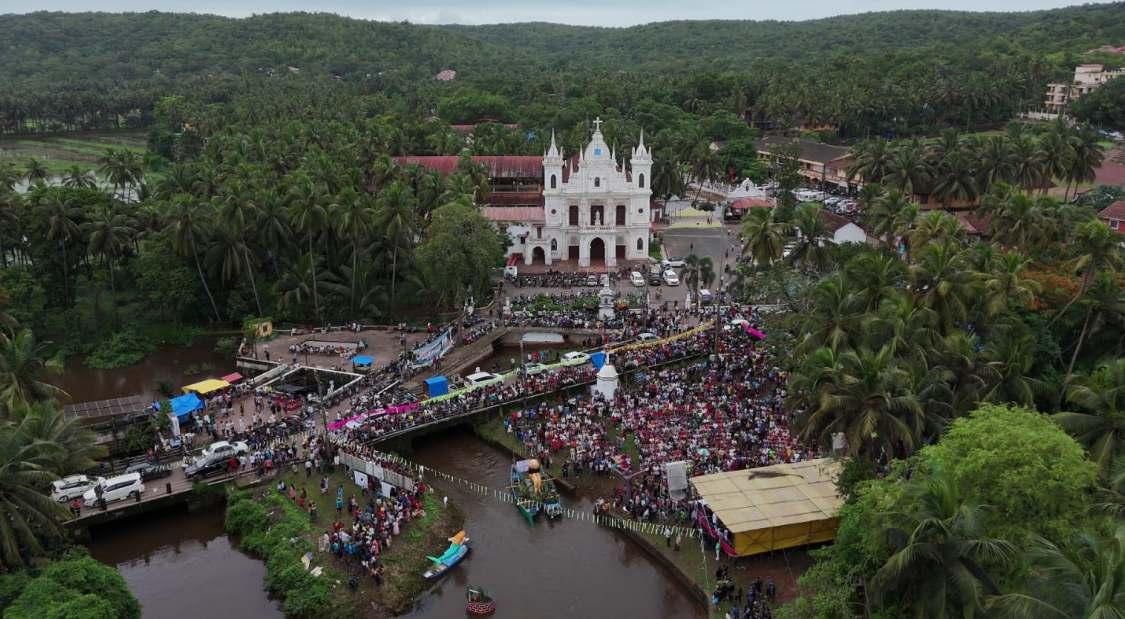
In a vibrant tribute to Goa's monsoon spirit and cultural traditions, the Department of Tourism, Government of Goa, in collaboration with the Siolim São João Traditional Boat Festival & Cultural Organisation, will host the spectacular Siolim São João Festival 2025 on 24th June. Set against the picturesque riverside opposite St Anthony's Church, Siolim, the festival promises a
colourful celebration of heritage, music, and community pride.
Dignitaries Set to Grace the Occasion
The grand event will witness the presence of several dignitaries, including Shri Rohan A. Khaunte (Tourism Minister), Shri Nilkant Halarnkar (Fisheries Minister), Dr. Ganesh C. Gaonkar (Chairman, GTDC), Smt. Delilah Lobo (MLA, Siolim), Shri Michael Lobo (MLA,
financial independence. Real Stories, Real Impact
Young women like Gauri Naik from Merces and Sulbha Karpe from B a n a s t a r
w h i l e learning, and inspiring others to do the same.
Spreading Financial Literacy, One Household at a Time
The scheme empowers women to b e c o m e B i m a Sakhis—ambassadors of financial literacy helping rural families understand insurance, savings, and financial planning, creating a ripple effect of awareness and security.
A National Model in the Making
Supported by other initiatives like the Rural Livelihood Mission and SHG funding programs, the Bima Sakhi Yojana is a powerful blend of employment, education, and empowerment.
In Goa, this is not just a policy—it's a movement for women-led progress, rewriting the story of f i n a n c i a l i n c l u s i o n , o n e empowered woman at a time.
Calangute), Shri Sanjeev Ahuja, IAS (Secretary, Tourism), Shri Kedar A. Naik (Director of Tourism), and Shri Kuldeep Arolkar (MD, GTDC), reaffirming the state's strong support for community-led cultural initiatives.
A Boat Parade Like No Other
The highlight of the day will be the traditional boat parade, where lavishly decorated floats glide down the river, showcasing Goa's artistic expression and festive identity. This year, Goa Tourism will present its own float, featuring a newly introduced monsoon mascot and a specially c h o r e o g r a p h e d d a n c e performance that blends culture with creativity.
Celebrating Heritage Through Music and Ritual
The event's rich program includes traditional folk dances, live music, and time-honoured customs like well-jumping, Kopel competitions,
Oze, and Dhali rituals each symbolizing fertility, joy, and the spirit of São João.
Modern musical acts by Clay Jars and a special performance by Johnny B Gud with Reza will infuse youthful energy into the age-old celebration.
A Cultural Tourism Milestone
Calling Siolim São João a “cultural expression of our monsoon identity,” Director of Tourism Shri Kedar A Naik emphasized its role in promoting sustainable, authentic tourism that celebrates local pride. With its engaging mix of tradition and innovation, the Siolim São João Festival 2025 invites locals, tourists, and culture lovers alike to experience an unforgettable afternoon of music, rituals, and riverside revelry—making it a true monsoon celebration like no other.



NEOMI & MARIO
The Quiet Architects of Goa's Grooming Revolution
It's not every day that a brand in the beauty industry feels as human as the people behind it. Yet, step intoanyNeomissalon,andthere'sanunmistakablesenseofwarmth,familiarity,andtrust,something thatglossynationalchainsoftenlack.Thesequalitiesaren'ttheresultofclevermarketingorimported strategies; they are the living values of its co-founders, Neomi and Mario, who together transformed Goa'sgroomingsceneandintroducedtheconceptofatruefamilysalontothestate.
Their journey is not just a tale of business growth but one of vision, grit, and deeply rooted passion, onethatbeganlongbeforethefirsthaircutwaseverdoneundertheNeomisbanner.
By Rajesh Ghadge

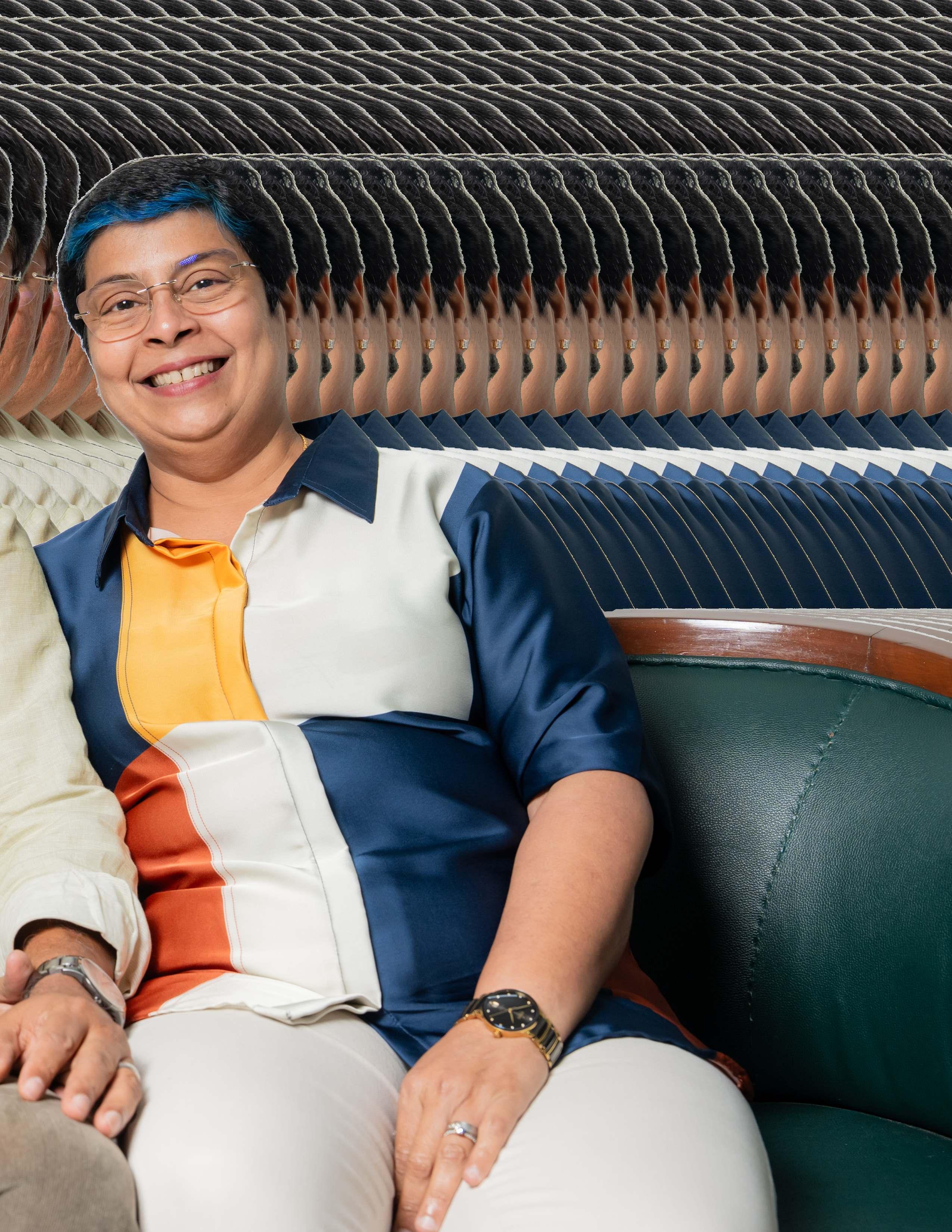

THE HUMBLE BEGINNINGS: A DREAM ROOTED IN TWO CITIES
“Yeah, it was started by both of us,” Mario says, smiling as he reflects on the early days. “She was in Dubai, and I was working in Bombay. After gaining enough experience in the beauty and hair industry, we both knew it was time to come back and start something of our own.”
Neomi nods, adding, “The plans were already in place. I had spent almost three and a half years working in Dubai, and Mario was settled in Bombay. But both of us were clear that we wanted to return to Goa, start fresh, and build something that felt ours.”
Their return to Goa wasn't entirely blind Neomi's brother, who was in finance with Anagram, had already established business contacts in the state. His connections and market understanding proved instrumental. “He had links with many people in the business world,” Neomi explains. “Through him, we were able to get a sense of how the Goan market worked.”
That insight was crucial — especially because, at that time, Goa's salon industry was still in its infancy. “When we did a market survey across Goa, particularly in Panjim, we noticed a stark gap,” Mario explains. “Salons were either for ladies or for gents and there was nothing that catered to both under one roof. The only unisex setup we found was at Cidade Goa.” “And even that,” Neomi interject, “was part of a fivestar property. It wasn't a place where the everyday Goan felt comfortable walking in. It was too exclusive, too elite.”
Having worked with premium clientele, Mario at the Oberoi and Neomi serving clients who would fly to Bombay just for her services the duo felt confident that they could offer
something better: a salon that combined fivestar standards with local accessibility. That seed became the blueprint for what would eventually become a brand called “Neomis”.
STARTING SMALL, THINKING BIG
With support from Neomi's brother and their shared determination, the couple began scouting for locations. Their first breakthrough came in the form of a small shop in Miramar, just 28 square metres, with a tight mezzanine. “It was tiny, but it was ours,” says Neomi. “We set it up simply Gents' services were downstairs with Mario and one male staff member. Upstairs, I worked with two girls offering beauty treatments, waxing, facials, & hair services. We did everything ourselves.”
“In the beginning, it was tough,” she admits. “There was no glamour. No fancy branding. Just hard work. But we had a clear vision to bring a true family salon experience to Goa. A space where the entire family, men, women, and children could feel at ease and cared for.”
The salon industry in Goa was a different world back then. “By 7 or 7:30 in the evening, the whole city would shut down,” Neomi recalls. “But we kept working. That made us stand out. People began to rely on us simply because we were still open when no one else was.”
Mario adds, “We worked from 9 AM to 9 PM every single day. No breaks. We'd go home, sleep, and start again. That rhythm created consistency, and clients began to trust us.”
It didn't take long for word to spread. “From the very first month, we were packed with appointments,” says Neomi. “And it wasn't just locals but even our old clients from Bombay who knew us started coming to Goa to get their services done here.”
GROWTH, GRIT, AND THE GYM GAMBLE
With business booming and client confidence growing, expansion was the next logical step. As luck would have it, the neighbouring shop next door went up for sale. “We saw it as an opportunity,” Mario says. “It was a good-sized property, and it had extra space at the back. That's when the idea struck, why not open a gym?” Neomi explains, “At that time, combining a salon with a gym was a trend. We already had the space, so it just felt like a natural extension of what we were building.” It wasn't a whimsical decision. The couple approached it with strategy and care. “We were fully invested in making the gym work.” The dual concept quickly gained attention. “Clients would come for their salon appointments and discover there was a gym too. It worked in synergy,” Mario says. “The gym got popular very fast.” So why let it go? “It was doing really well,” Neomi says with a thoughtful pause. “In fact, the gym had become a brand in itself. But we realised we needed more space for the salon. And we couldn't do justice to both ventures.”
Mario agrees, “Our expertise was in beauty. We weren't gym specialists. So we made a call, we shut down the gym and used the space to expand the salon.” It turned out to be the right decision. The Miramar salon flourished with more room, more clients, and better services. GOING SOUTH: THE LAUNCH OF COLVA BRANCH
With the flagship branch thriving, the duo began exploring opportunities in South Goa. “We had always wanted to reach out to the southern clientele,” Neomi says. “So in June 2000, three years after our first salon, we opened our second outlet in Colva.” This time, they had help from family. “My mother had come down from Mumbai,” Neomi shares. “We trusted her with managing the Colva branch. She understood the business, and she ran the place while we kept moving between North and South.”
With two successful outlets, Neomi and Mario had now built more than just a business, they had birthed a brand. “That was the real turning point,” Mario recalls. “We started hiring more staff, training them, upgrading our services and systems.” Neomi adds, “We started in 1997, and this June we complete 27 years. It's surreal to think how far we've come.”
SCALING UP – THE SILENT STRUGGLE BEHIND THE SALON SUCCESS
Growing a salon brand is one thing. Sustaining it with consistency across years across locations is an entirely different challenge. Neomi and Mario didn't just open branches; they created a culture of grooming that became second nature to thousands of Goans. But behind the sleek salon chairs and loyal clientele lay years of relentless struggle, especially when it came to staffing “The





biggest challenge we face today is finding and retaining good, trained staff,” Mario says candidly “We invest months into training someone, and the moment they feel confident, they want to open their own salon.”
Neomi nods, her tone reflective rather than resentful “It's happened many times And we ' re okay with that We've always encouraged our staff to grow. Some of them are still in touch, they'll call for help, ask for advice. We're happy to support them.”
The issue, however, lies in finding new talent willing to dedicate themselves the same way. “That's become harder,” Mario says. “Earlier, people were willing to put in long hours and learn Salaries were lower, but they were committed. Today, salary expectations are higher, but people want to leave by 6 PM.” Neomi adds, “Times have changed. Clients have changed too. Earlier, they would wait 15–20 minutes for their appointment. Now, if you ' re not ready, they'll walk out and go somewhere else.”
And in the age of Google reviews and social media, there's no room for error. “We've told our staff if someone's in a rush and the service will suffer, don't take the appointment,” Neomi explains. “It's better to reschedule than risk a poor job. One mistake and you get a one-star review and to pull your rating back up, you need 50 five-stars.” Mario adds, “That's how
digital platforms work now. Clients are vocal, and public perception matters. You have to be at the top of your game all the time.”
To maintain their digital presence, Neomis now has an in-house social media and grievance response team. “We respond to queries and
c o m p l a i n t s immediately,” Neomi says. “We also shoot a lot of our own content
b e f o r e - a n d - a f t e r photos, transformation videos, tutorials. We h a v e o u r o w n photographer and videographer.”
This consistent content strategy has paid off. “We get inquiries from across the country, Belgaum, Pune, Bengal, D e l h i , ” s h e a d d s “People may not know me personally, but they
k n o w t h e N e o m i s brand. And that's what matters now.”
Mario agrees “We've built something that people recognize and t r u s t T h a t ' s t h e strength of our brand today.” Still, for Neomi, brand-building has never been about chasing new customers alone “We tell our t e a m t o w o r k o n retaining your existing c l i e n t s B u i l d relationships Know their preferences, their likes, their history.”
This focus on emotional connection has shaped the Neomis experience.
“Some clients come every week,” Neomi says with a smile. “They feel so relaxed here they literally fall asleep in the chair! That's the kind of comfort we've created.”
THE REAL ESTATE TURN – NEOSPACES IS BORN
As Neomis continued to thrive, Neomi felt the stirrings of a new calling one that came not from a business plan, but organically from her trusted relationships with clients. What began as casual conversations during beauty appointments soon opened the door to a completely new venture. “Before COVID, I started getting more and more requests from clients,” Neomi explains. “Some of them were seniors who had been stuck in Goa for longer than expected. Others wanted to downsize. A few were going through financial difficulties. But instead of asking for a haircut, they were asking for help selling their houses.”
At first, Neomi would refer these leads to brokers, many of whom were also her clients. But one day, a regular customer questioned her approach. “Why are you handing this off to someone else?” the client asked. “You're the one we trust. You're the one actually helping us. You should be doing this.” That moment, Neomi says, stayed with her.
Soon after, she took her first deal, an apartment in Succoro, North Goa. It was a smooth, successful transaction. “That gave me a boost,” she says. “I realised I could actually do this.” The next opportunity was far more challenging, a full building at Patto It





















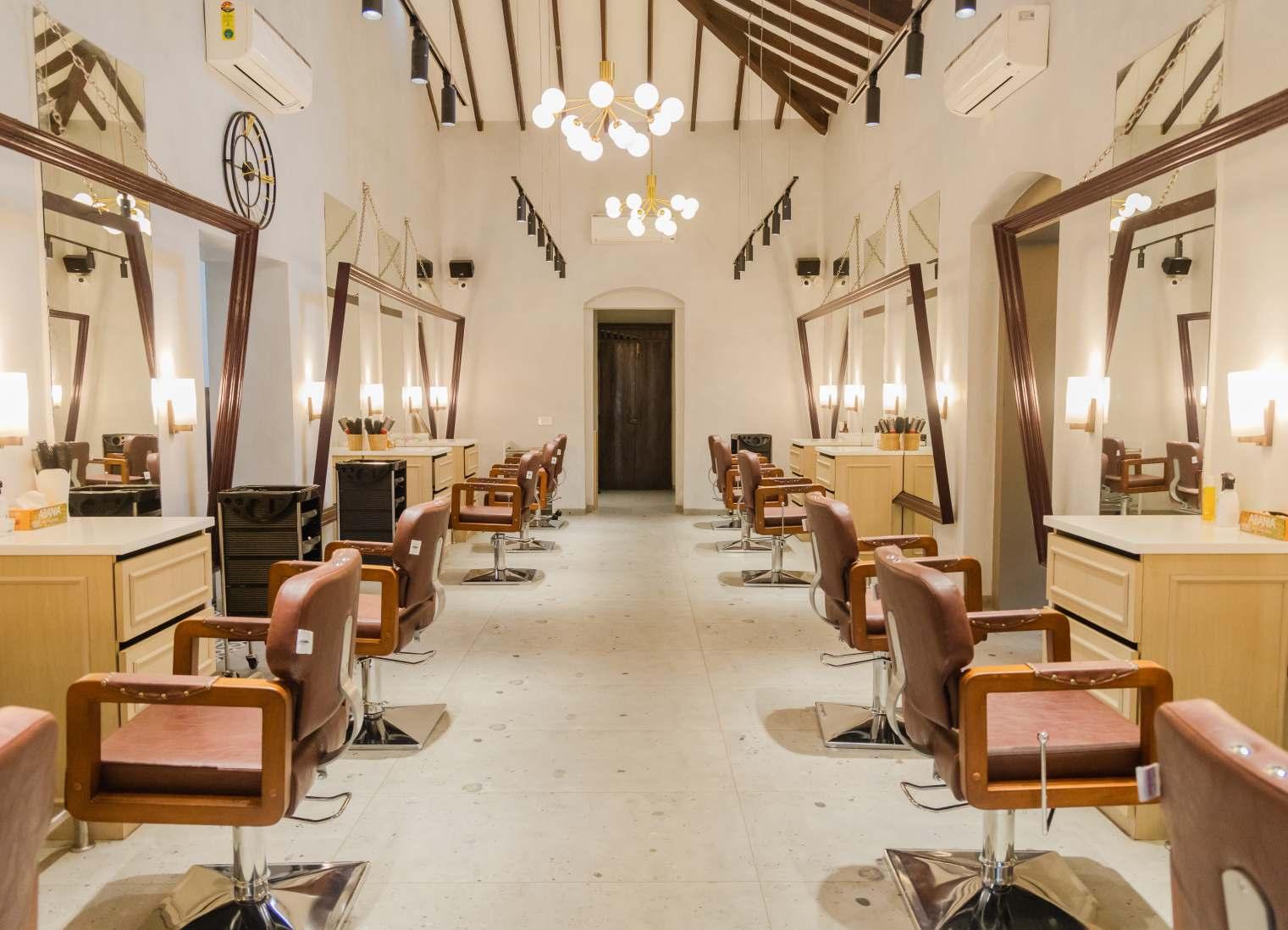
belonged to another long-time client. “It was a big project,” she recalls. “And it took a lot of negotiation. But I closed it and that gave me the confidence to keep going.”
Today, NeoSpaces is a licensed, registered real estate consultancy firm with over 100 completed transactions. Neomi handles everything from resale flats and villas to rentals, document verification, and even complex legal handovers. But what sets her apart is the personal touch. “Most of my clients are senior citizens. Many of them don't have proper paperwork. I help them sort everything out, sometimes at no charge. It's not about commission. It's about doing the right thing.” True to her minimalist marketing style, Neomi never advertised NeoSpaces aggressively. “I just put a couple of posters outside my Miramar and Margao salons. That's all. And the calls started coming in.” Her reputation grew quickly. Other brokers began approaching her, not as competitors, but collaborators. “They know I don't undercut. I believe in working with people, not against them It's the same philosophy I built Neomis on.”
So what's next? “I want to become a smallscale developer,” she says with an enthusiastic grin. “Not some big-shot builder. But start with small, quality projects. Something meaningful, something real.” And knowing Neomi, that dream is already in motion quietly, organically, just like everything else she's built.
LEGACY IN MOTION – TRAINING THE FUTURE, HANDING OVER THE BRAND
With Neomis firmly established as a household name across Goa, Neomi and Mario have entered a phase of reflection, not just about the brand's future, but their own evolving role
within it After nearly three decades of relentless work, they've earned the right to pause, reassess, and reprioritize. “We don't want to expand anymore,” Mario says with quiet clarity. “The focus now is to maintain what we've built to sustain the quality and the legacy.”
One of the key reasons behind this shift is personal. Their children, both studying abroad, have already expressed that they do not plan to join the family business. “They've told us clearly that their aspirations lie elsewhere,” Neomi shares. “And we respect that. It's their life, and they have their own dreams.”
It's a reality many legacy entrepreneurs in traditional industries face today the next generation choosing different paths. But for N e o m i a n d M a r i o , i t ' s n o t a b o u t disappointment. It's about staying grounded in purpose. “We never started Neomis just to grow endlessly,” Mario says. “We built it to last. And that's what we ' re focused on now, preserving what we created with integrity.”
That said, the door isn't closed. “We're open,” Neomi says thoughtfully. “If someone comes along, someone who understands what Neomis stands for, we're ready to support them, guide them, and eventually pass it on. But we're very clear: it has to be the right person, someone who gets the culture, not just the commercial side.”
This commitment to values and standards is what gave rise to their latest venture The Mario's Academy. “It started out of necessity,” Mario explains. “We kept facing the same issue, a shortage of well-trained staff. So we decided to create our own training ecosystem ” They bought additional shops
near their salon and converted them into a fullfledged training academy. “We now train not only our own team but also professionals from other salons,” Neomi shares While the diplomas offered aren't government-certified, they hold weight within the industry. “Cruise liner recruiters like Steiner know the kind of training we offer,” Mario says. “They know that a therapist from Neomis is reliable, skilled, and professional.”
Neomi adds, “Our staff learn on the job especially correction work, which is rare. When clients come with damaged hair from other salons, we fix it. That's when our team learns the real value of consultation, product understanding, and diagnosis.”
Their academy also focuses on empowering the staff to educate clients. “Today's clients are informed. They ask questions,” Neomi explains. “So we train our team not just to execute services, but to explain what they're doing and why.”
This emphasis on education, transparency, and technical excellence has helped Neomis cultivate a reputation that goes far beyond its physical outlets. It has created a ripple effect a new standard for Goa's grooming industry.
THE HEART OF THE BRAND
In the end, what truly defines Neomis is not just its success, scale, or even its longevity, but its soul. It's a brand built not for flash, but for family. And that's reflected in the way Neomi and Mario continue to nurture both their staff and their clients. “A lot of our clients have become friends,” Mario says with a smile. “Some come every week, some just drop in to relax. There are parents who leave their kids here while they run errands, or seniors who feel safe and at ease. That trust you can't buy it.” Neomi nods in agreement. “We're not running after limelight. We've done our part. Now it's about sustaining what we have without stress, without pressure.”
Their commitment has always been to doing things the right way. “This business gave us everything,” Neomi says quietly “Respect, income, learning, relationships. Now, we just want to give back through mentorship, through the academy, through honest service.”
Their story isn't about chasing trends or reinventing for the sake of it. It's about building something real. Something that can outlive them. “As long as our pockets are warm,” Neomi says with a chuckle, “we don't need the spotlight. We want peace, pride, and a brand that continues to make people feel good.”
And perhaps that's the most beautiful part of the Neomis journey. It was never just a salon. It was and will remain a legacy built on trust, love, and the quiet conviction that doing the right thing will always be in style.




TROUBLE IN TAXI PARADISE Goa's Tug of War Over App-Based Cabs
By Gauri Ghadge
How a small coastal state became the epicentre of a modern mobility battlewith livelihoods, tourism, and trust all on the line.
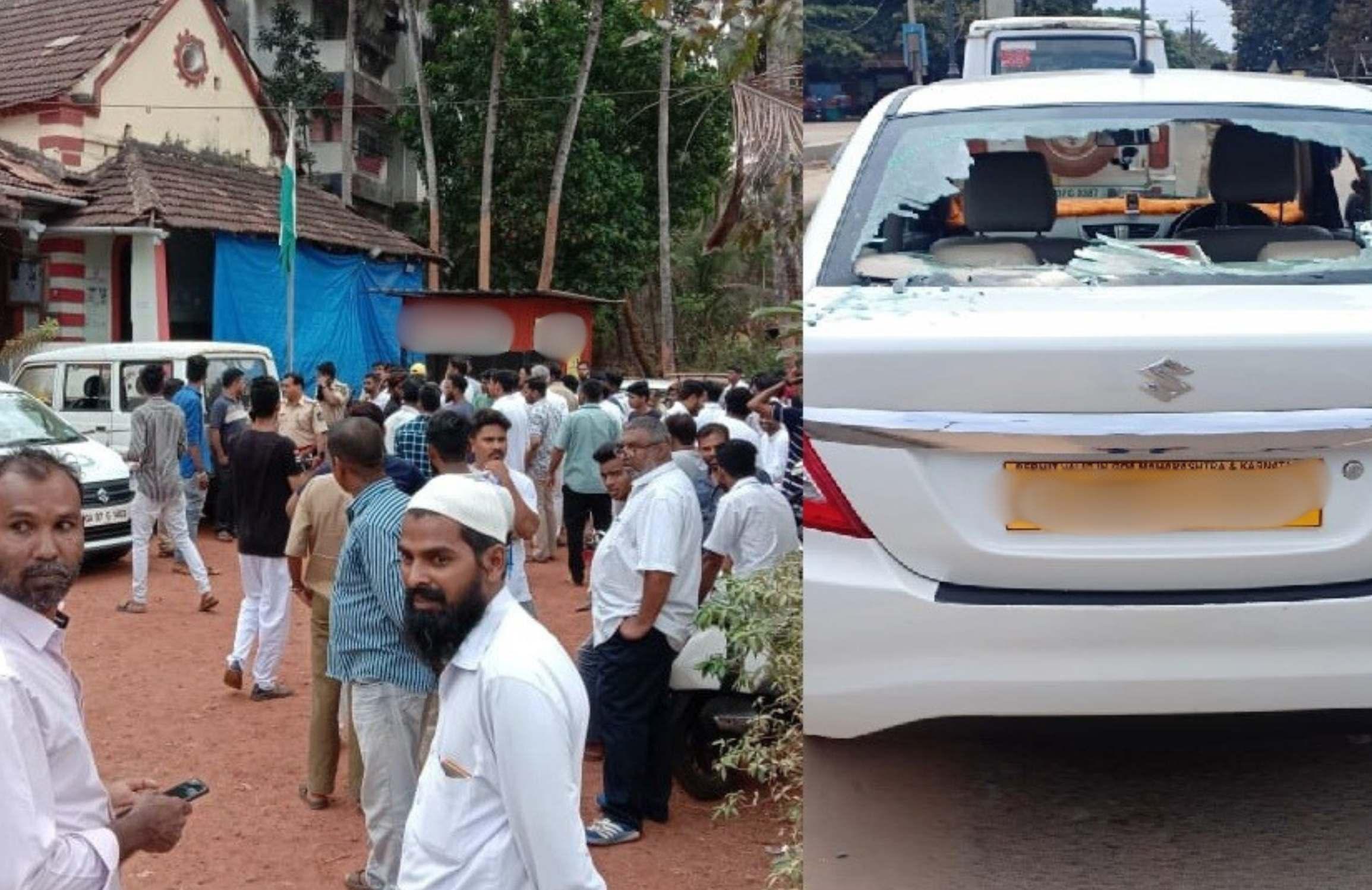
It was a sunlit April morning in Varca, South Goa, when a UK-based family, in town for a wedding, prepared to leave their resort for the airport. Their luggage was packed, children ready, and flights scheduled. They had done what most global travellers are used to doing: booked taxis online in advance. But what followed was something they had never imagined in a state famed for its hospitality. As their cabs pulled into the resort driveway, a group of local taxi operators confronted the drivers, blocked the exit, and began banging on the vehicle windows. The family watched helplessly from inside as the drivers were threatened, pressured, and abused. “You won't leave until you pay us, ” one local driver allegedly said. Fearing escalation and missing their flight, the drivers reluctantly handed over �5,000 in cash. Only then were they allowed to exit the premises.
The incident, which took place in April 2025, was reported to the Colva police and widely covered in the press. It was not an isolated confrontation, but rather a flashpoint in a growing storm that has gripped Goa — a state where transportation has become the frontline of a battle between the old and the new, the local and the digital, the protected and the progressive.
This wasn't just a dispute over a ride. It was a symbolic collision between generational livelihoods and app-based convenience, b e t w e e n l o c a l m u s c l e a n d g l o b a l expectations When the Goa government proposed opening its doors to national taxi aggregators like Ola and Uber, the backlash was swift, emotional, and deeply political. In a matter of weeks, what began as a draft policy evolved into a full-blown public reckoning. At stake is more than just mobility. It is the very soul of Goa's transport identity, and whether the state can navigate change without losing what makes it uniquely its own.
A S Y S T E M B U I LT O N T R U S T A N D TURBULENCE
For decades, Goa's taxi drivers have operated in a unique space, often family-run, deeply local, and community-rooted. These drivers don't just transport tourists; many offer guided experiences, tips on hidden beaches, and language help But the charm has long coexisted with criticism.
Visitors frequently lament the absence of meters, unpredictable pricing, and the lack of transparency in fare negotiations. “It's like playing roulette every time you need a ride,” says Meera, a German expat living in Assagao. “Sometimes the fare is �500, sometimes �1500 — for the same trip.”
Local residents, especially women, also express concerns. Many avoid taxis altogether
at night, citing safety and cost issues. “You feel vulnerable no tracking, no ratings, no accountability,” shares Shraddha Naik, a hospitality worker who finishes her shift in Panaji past 10 PM.
THE SPARK: A DRAFT POLICY THAT CHANGED EVERYTHING
In May 2025, the Goa government released the Draft Transport Aggregator Guidelines, a document that quietly stirred a storm.
The guidelines aimed to allow private aggregators like Ola and Uber to operate under strict regulatory conditions:
Ÿ Only Goa-registered vehicles with Public Service Vehicle (PSV) permits could be onboarded
Ÿ No commission deductions from fare payments to taxi owners
Ÿ Mandatory health and accident insurance for drivers and incentives for onboarding women
Ÿ GPS tracking, fare transparency, and grievance redressal are built into the digital platforms
At face value, it was a bold attempt to marry innovation with local protection The government even offered full fee waivers for app aggregators onboarding female drivers, and stiff penalties of up to 50 lakh for violations For many in the business and tourism sectors, it seemed like a long-overdue reform.
But for local taxi operators, it sounded like the death knell of their livelihoods.
THE UPRISING: RESISTANCE FROM THE GROUND
Goa's taxi unions, fiercely independent and tightly knit, swung into action.
Mass protests erupted across the state. Outside Junta House in Panaji, hundreds of taxi drivers assembled in protest. In North Goa, prohibitory orders were imposed under Section 144 to prevent gatherings Memorandums were submitted to MLAs, and appeals echoed from coastal constituencies like Calangute and Candolim.
“We are not against technology,” said Sunil Naik of the All Goa Taxi Association. “We are against outsiders destroying our way of life.”
Their argument: the entry of national aggregators would undercut prices, empower non-Goan operators, and eventually wipe out thousands of small local businesses. Many of these drivers own their vehicles through loans and operate on thin margins. The prospect of
algorithmic fare cuts, high aggregator commissions, and unpredictable digital systems left them anxious.
Political leaders, many of whom rely on these unions for ground-level support, were quick to react. Mixed reactions flowed in, as some were for, and some against. The situation escalated until Chief Minister Pramod Sawant stepped in, with a decisive announcement: Ola and Uber would not be allowed to operate in Goa.
THE OTHER SIDE: TOURISTS, WOMEN, AND THE DIGITAL GENERATION
While the taxi unions celebrated a temporary victory, not everyone rejoiced.
Across social media, WhatsApp groups, and travel forums, Goa's tourists and locals expressed sharp disappointment. The absence of app-based taxis has long been a deterrent for travellers used to the comfort of digital convenience. Stories of tourists being quoted �3,000 for short rides, or being stranded in remote areas have become all too common.
“I love Goa, but I now hesitate to recommend it to friends who travel solo,” says Avinash, a frequent visitor from Bengaluru. “The stress of negotiating a taxi after every meal or beach visit kills the holiday vibe.”
More significantly, a growing movement led by Goan women began to speak up. Petitions and columns highlighted how app-based services are not just about pricing, but about safety, independence, and access. With features like GPS tracking, SOS buttons, and driver ratings, aggregators offer a layer of security that's hard to replicate in offline systems.
WHAT ABOUT GOA MILES AND THE GOA TAXI APP?
To counterbalance the demand for modernisation, the state introduced GoaMiles in 2018 and later the Goa Taxi App in 2023. These local digital platforms were meant to digitise the existing taxi ecosystem without displacing local operators.
While well-intentioned, they've faced criticism for limited coverage, inconsistent availability, and poor user experience. Only about 5,000 of Goa's 12,000 tourist taxis are on these apps. Moreover, despite government backing, many drivers distrust these platforms or don't understand how to use them.
But recent weeks have seen a spike in GoaMiles downloads — an indicator that the public is hungry for solutions, even if imperfect.
THE BUSINESS OF GETTING AROUND
For the tourism industry, the taxi issue isn't a side problem; it's a core economic challenge. Travel and Tourism Association of Goa (TTAG) conducted a public poll: over 93% of

respondents supported the entry of appbased services. Hotel owners report frequent complaints from guests, especially international travellers who arrive expecting global standards of mobility.
The Confederation of Indian Industry (CII) warned that resisting technology could hurt Goa's competitiveness. “This is not about Ola or Uber. It's about transparency, accessibility, a n d r e p u t a t i o n , ” s a i d a s e n i o r C I I representative. “Goa needs to evolve, or it risks falling behind.”
POLITICAL CALCULATIONS AND
PUBLIC SENTIMENT
Chief Minister Pramod Sawant is no stranger to tightropes. Balancing local livelihoods and global tourism expectations is no easy feat. His decision to block Ola and Uber, while politically strategic, raises questions about long-term sustainability.
Insiders suggest that an internal compromise is being worked out one that could see regulated, Goan-owned aggregator platforms, possibly expanded versions of GoaMiles, receiving greater support.
Transport Minister Mauvin Godinho has indicated a willingness to work with unions to build a hybrid model, but the success of such an effort hinges on political will, technological support, and public trust.
FINDING THE MIDDLE PATH: WHAT SHOULD GOA DO NOW?
The challenge before Goa is not unique. Cities across the world, from Paris to New York have faced similar upheavals when digital
disruptors enter entrenched local markets. The solution lies not in resistance or unchecked adoption, but in adaptation.
Here's what a balanced mobility future could look like for Goa:
Ÿ A unified digital platform backed by the government, integrating local taxi drivers with modern app features
Ÿ Transparent, fixed fare slabs based on distance, time, and peak hours
Ÿ Mandatory training for drivers in customer service, digital literacy, and road safety
Ÿ Incentives for women drivers and enhanced security features for all passengers
Ÿ Collaborations with hotels and tourism bodies to ensure consistent standards of service
In short, Goa must reimagine what a "Goan taxi" means in the 21st century.
F I N A L T H O U G H T S : G O A AT T H E CROSSROADS
Goa's taxi controversy is no longer just a conflict over rides. It has become a symbol of a deeper unease, a society caught between heritage and transformation.
This land has always thrived on dualities — Latin arches and Konkani courtyards, trance festivals and temple feasts, barefoot freedom
and premium luxury. Yet, in the simple act of trying to get from point A to B, those contrasts have turned into confrontation.
This isn't just a debate about technology versus tradition. It's about power — who has it, who's losing it, and who never had it to begin with. It's about the Goan taxi driver who wakes up at dawn to earn his keep, now afraid his next passenger might vanish into an app It's about the solo woman traveller refreshing her screen at midnight, hoping a ride will appear — and knowing, in Goa, it likely won't. It's about a generation that wants to move forward, and a system that keeps circling back.
The absence of Ola and Uber isn't just inconvenient, it's revealing. It shows us what we've protected, what we've neglected, and what we still fear to confront: that Goa, for all its charm, is struggling to design a future where everyone moves freely, not just physically, but socially and economically.
If Goa is serious about being a world-class destination, it can't afford a fractured transport system Because no amount of sunshine or sea breeze can hide the discomfort of being stranded, overcharged, or unseen.
To truly live up to its name — not just Incredible Goa, but equitable, inclusive Goa- the state must build bridges, not barriers. A transport system that values people over politics. A model that doesn't ask Goans to choose between dignity and digital evolution, but gives them both.
Because the road ahead is more than just infrastructure; it's a test of imagination, empathy, and will.
And the real question isn't whether app-based taxis will come.
It's whether Goa can find the courage to create a future where everyone has a seat, and no one gets left behind.


S T R E N G T H E N I N G T H E BACKBONE OF COASTAL GOA
Government Schemes Supporting Fishermen
By Gauri Ghadge


In Goa, fishing is more than an occupation. It's a lifeline, a legacy, and for many, the only source of livelihood. From pre-dawn launches to the unpredictability of the sea, every trip offshore is a calculated risk. Recognising the immense contributions and hardships of this community, the Government of Goa has introduced a series of well-crafted welfare schemes to support traditional fishermen —
financially, structurally, and most importantly, with dignity.
In this In-Focus feature, we examine four key schemes that are transforming the lives of Goa’s fisherfolk, offering relief, safety, empowerment, and long-term resilience.
1. NATURAL CALAMITY RELIEF: A SAFETY NET IN TIMES OF CRISIS
The sea gives, but it also takes Goa’s fishermen are often at the mercy of cyclones, floods, fires, and unexpected oceanic accidents To reduce the impact of such tragedies, the state’s Natural Calamity Relief Scheme ensures compensation across a wide range of losses.
In the heartbreaking event of death or total disability while fishing in the sea or river, the government offers a compensation of 5,00,000. For damaged or destroyed equipment, the compensation structure is tailored and fair:
Ÿ Fishing Canoes: Up to 1,00,000 for partial damage; �2,00,000 for total loss with OBM.
Ÿ Fishing Vessels: �7,00,000 for 1–4 cylinder vessels; �10,00,000 for 6–8 cylinders.
Ÿ Fishing Nets: Gill nets (�50,000), trawl nets ( 50,000), rampon nets ( 1,00,000), and purse seine nets (�5,00,000) — based on the actual loss value.
Eligibility is extended to those contributing to the Fishermen Corpus Relief Fund and whose fishing assets are registered with the Department of Fisheries. The application must be submitted within one week of the incident, along with documents such as the vessel


registration, biometric ID, loss assessment reports, and, in case of fatalities, FIRs and medical certificates.
In addition, the Department offers a dedicated grievance redressal system, e n s u r i n g t r a n s p a r e n c y a n d t i m e l y communication within 30 days of complaint submission.
This scheme is a firm testament that when disaster strikes, Goa stands by its fishermen.
2 . L I F E F I R S T : A S S I S TA N C E F O R LIFEJACKETS AND LIFEBUOYS
Every fisherman deserves to return home safely. To enhance safety standards on Goa’s waters, the government offers financial assistance to purchase lifejackets and lifebuoys, making it easier for fishermen to afford this life-saving equipment.
The scheme subsidises:
Ÿ Rs 1,000 per lifejacket
Ÿ Rs 1,500 per lifebuoy
The quantity permitted depends on the vessel:
Ÿ Canoe with OBM: 5 lifejackets and 1 lifebuoy
Ÿ Mechanised Trawlers (Trawling): 8 lifejackets and 2 lifebuoys
Ÿ Mechanised Trawlers (Purse Seining): 25 lifejackets and 4 lifebuoys
Applicants must be traditional fishermen by birth or profession, residing in Goa, and owning eligible fishing vessels Required documents include the updated fishing license, vessel registration certificate, Aadhaar card, and a bank mandate form.
Offline applications can be submitted to the Department of Fisheries or its designated offices Grievances are addressed swiftly through official channels or via email to dirfish.goa@nic.in.
By prioritising preventive safety, this scheme helps fishermen navigate the seas with greater confidence and peace of mind.
3. FUELING INDEPENDENCE: SUBSIDY FOR WOODEN/FRP CANOES
Ownership of a fishing vessel is a matter of pride and independence for traditional fishermen. Yet, the cost of constructing or purchasing a new canoe — especially wooden or FRP models — can be out of reach for many. The state government bridges this gap with its Financial Assistance Scheme for Wooden/FRP Canoes.
The support includes a 50% subsidy, limited to:
Ÿ 60,000 for general category
Ÿ 80,000 for SC/ST beneficiaries
Each household is eligible once every four years, and the canoe must be registered under the Marine Fishing Regulation Act (1980) or Merchant Shipping Act (1958).
To protect the integrity of the subsidy, the scheme mandates that the canoe must not be sold, leased, or mortgaged for five years, and must be used solely for fishing.
Applicants must submit documents such as:
Ÿ Updated fishing license, net license, and netbook
Ÿ Vessel registration certificate
Ÿ Original GST bill from authorised dealer
Ÿ Caste certificate (if applicable), Aadhaar, voter ID, and bank passbook
Through this initiative, the state not only fuels economic empowerment but also ensures Goa’s age-old fishing culture continues to thrive independently.
4. EQUIPPING THE ESSENTIALS: SUBSIDY FOR FISHERIES REQUISITES
No fishing journey is complete without proper gear. For those who already own registered canoes, the government offers a dedicated scheme for purchasing gill nets and river gill nets with accessories.

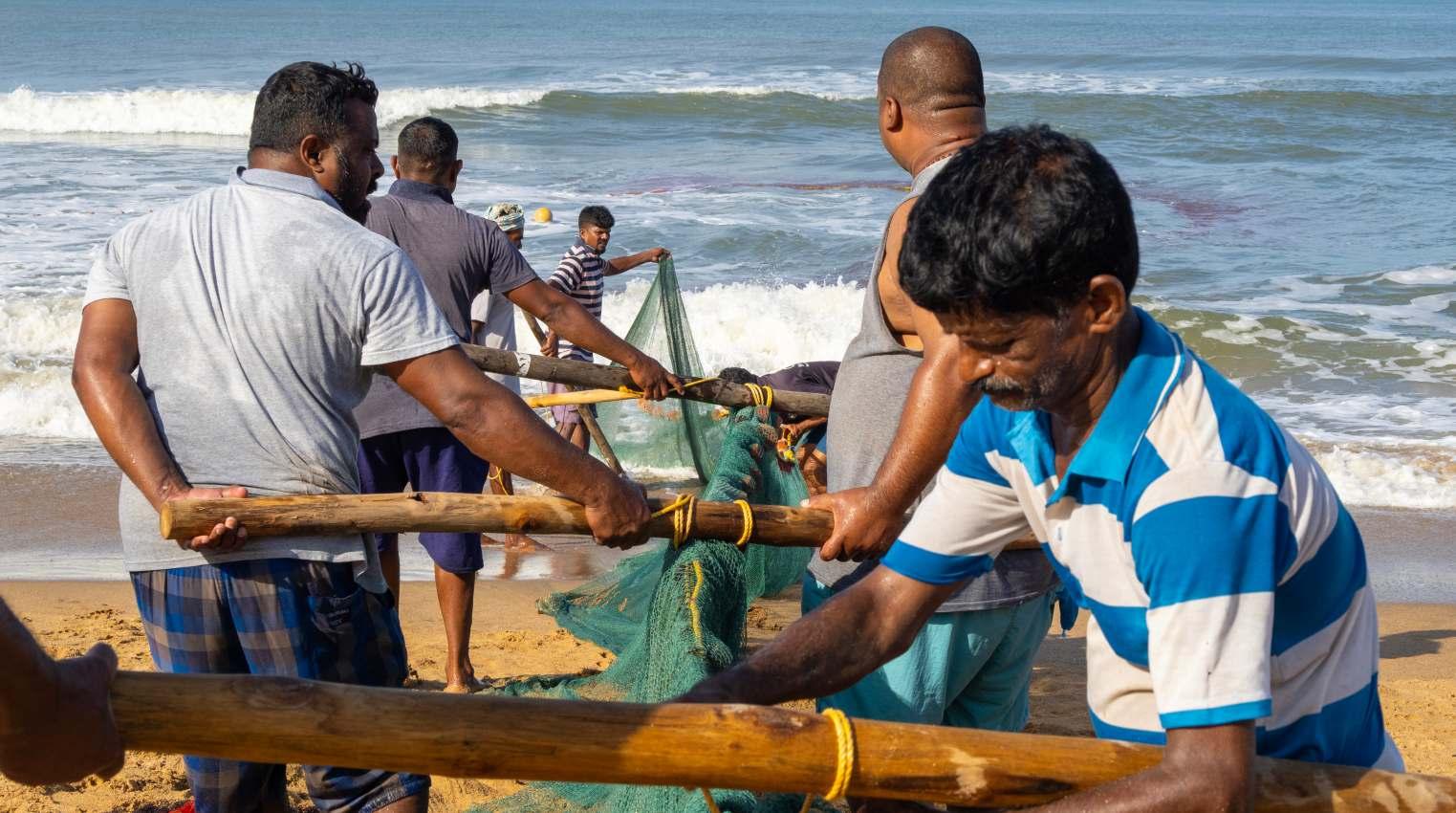
This assistance includes:
Ÿ 50% subsidy up to Rs 30,000 for general category fishermen
Ÿ 50% subsidy up to Rs 40,000 for SC/ST category
Eligibility is reserved for traditional fishermen residing in Goa, who are not defaulters with the Directorate of Fisheries. The equipment
purchased must come with a valid GST or VAT bill from an authorised dealer, and once acquired, it cannot be sold or transferred for five years.
Key documents include:
Ÿ Fishing vessel and net license certificates
Ÿ Updated netbook
Ÿ Caste and ID proofs, including Aadhaar and voter card
Ÿ Bank details and inspection report with photographs of the canoe and net
Applications follow an offline format and can be submitted at any Fisheries office. Grievances, if any, are resolved within 30 days via the standard redressal process.
By ensuring fishermen are fully equipped with efficient, modern tools, this scheme helps boost both catch quality and income security.
A VISION ANCHORED IN SUSTAINABILITY AND WELFARE
Together, these four schemes form a robust framework that supports Goa’s fishing community through all stages: from crisis recovery to daily survival, equipment upgrades to asset ownership The Directorate of Fisheries, through its well-designed policies, ensures that no fisherman is left behind, whether in storm or sunshine.
More than welfare, this is about respect Respect for those who rise before dawn, steer into uncertain tides, and return with the bounty that feeds our state.
Goa’s vision for its fisherfolk is clear: empower, protect, and uplift. These schemes are not handouts; they are anchors of opportunity.

H O W S O C I A L M E D I A FOREVER CHANGED GOA
By Gauri Ghadge

DESTINATION — AND THE RIPPLE
, PRICING, AND BEHAVIOUR
Not too long ago, Goa evoked images of hippie havens, golden beaches, soulful music, and the unhurried rhythm of susegad. It was India’s escape hatch; a place to unplug, wander, and rediscover simplicity. But today, Goa is no longer just a destination; it’s a brand. And no one built that brand faster or louder than social media. Scroll through Instagram or watch trending reels, and Goa looks like a lifestyle catalogue: pasteltoned villas, bohemian cafés, drone shots of palm-fringed coasts, floaty dresses at Cabo de R a m a , o r l a v i s h p o o l s i d e breakfasts in Assagao. The Goa we see online is stunning and yet, it’s not the whole truth. Social media didn’t just change how Goa is marketed; it transformed how people experience it, price it, behave in it, and even dream about it.
This is a deep dive into how social media aestheticised Goa — and why that shift changed it forever.
VISUAL REVOLUTION
The Goa of the early 2000s was dominated by travelogues and b l o g s T h e n a r r a t i v e w a s experiential a recounting of flea markets, bike rides, or moonlit music sessions on Arambol beach. But with the rise of Instagram and YouTube post-2015, Goa’s narrative became visual-first. The pivot was instant Stories
were replaced by snapshots. Reviews gave way to reels. Goa became the backdrop — influencers, the protagonists. In this new dynamic, aesthetics weren’t just an add-on; they were the main act.
Today, the most sought-after properties in Goa are those with photogenic corners: think candy-coloured Portuguese facades in Fontainhas, infinity pools with paddy views in Siolim, or hammocks framed just right for that perfect sunset click. And this transformation wasn’t accidental — it was algorithmic. Instagram’s grid, TikTok’s virality, and YouTube travel vlogs created a visual gold rush Businesses adapted fast Boutique hotels, cafés, and even yoga retreats redesigned their spaces to be more “Instagrammable.” Fairy lights, mural walls, rattan chairs, neon quotes — not necessarily for the visitor, but for the feed.
THE INFLUENCER ECONOMY: MARKETING REINVENTED
Traditional marketing for Goa — brochures, packages, and hoardings — slowly faded into the background. In their place rose influencers, creators, and digital nomads who turned content into currency.
Collaborations with influencers became a norm for cafés, fashion labels, real estate agencies, and even the Goa Tourism Department From barter stays to paid content, the influencer economy thrived. Why? Because data showed it worked.
A 2022 report by Expedia Group Media Solutions stated that 74% of travellers get trip inspiration from social media, and 60% of Gen Z travellers rely on influencers before booking a stay. Goa, being India’s most aspirational domestic travel destination, became ground zero for this shift.
Properties like Mojigao, Saz on the Beach, or The Postcard Hotel built entire digital identities that blended luxury with ‘authenticity’ — and it paid off. Some cafés saw footfall double within weeks of a well-crafted reel going viral. Even smaller homestays in interiors like Aldona or Moira began investing in aesthetics : vintage bathtubs, retro windows, artisan breakfasts ; all for the camera.
CHANGING BEHAVIOUR: TRAVEL AS PERFORMANCE
With the influx of content creators, the tourist behaviour in Goa subtly — but significantly — changed. Vacations became content trips. Moments were curated, not lived. Travellers now arrive with outfit changes for photoshoots, research ‘trending spots’ beforehand, and even schedule their sunset viewing based on lighting for reels. Beaches became sets Markets became aesthetic props. Even wellness retreats saw
guests breaking silence meditations for Instagram stories.
Localities like Parra, known for its coconuttree-lined road (popularised by the film Dear Zindagi), were swarmed with tourists halting traffic for selfies. The “Instagram-first” mindset overtook the “experience-first” spirit.
This behavioural shift didn’t go unnoticed by locals. Many Goans voiced concerns about their villages being reduced to visual clichés. The culture, history, and everyday life of Goa were often overlooked, replaced by a curated version optimised for digital validation.
THE AESTHETIC TAX: WHEN BEAUTY DRIVES PRICES
As Goa’s popularity on social media soared, so did its prices. Areas like Assagao, Anjuna, and Siolim once laid-back enclaves saw property rates skyrocket The trend of aesthetic homestays and boutique villas created a new luxury tier where charm came with a price.
A simple breakfast of avocado toast and cold brew could cost upwards of �800 at influencerfrequented cafés Hotel tariffs that were �2,500 pre-2018 now command �9,000 during season, often justified by “ambience” and “experience,” both euphemisms for social media-worthy aesthetics.
But this price inflation didn’t just affect tourists. Long-term renters, digital nomads, and even locals began feeling the pinch. The cost of living in trendier parts of North Goa soared, pushing out many Goans from their ancestral neighbourhoods.
This phenomenon is not unique to Goa Globally, cities like Bali, Tulum, and Lisbon have seen similar gentrification fueled by influencer tourism. But Goa, with its fragile infrastructure and seasonal economy, feels the impact more acutely.
LOSS
OF SUSEGAD? THE CULTURAL TENSION BENEATH THE SURFACE
The essence of Goa; its susegad, its earthy charm, its mix of Indo-Portuguese heritage — risks being overshadowed by digital demand. There’s a growing gap between “real Goa” and “Instagram Goa.”
Locals often lament that tourists don’t explore traditional markets, heritage homes, or village feasts anymore. Instead, they stick to curated trails fed by Google Maps and hashtags.
As a result, the economic benefits of tourism are often concentrated in pockets, while the cultural burden is widely distributed. Noise complaints, traffic congestion, waste mismanagement ; these are the invisible costs of Goa’s social media fame.
Yet, there is hope. Conscious creators and local entrepreneurs are working to bring depth
back into the narrative. Platforms like Soul Travelling, Make It Happen, and Museum of Goa are building experiences that go beyond the grid, encouraging storytelling, slow travel, and cultural immersion.
A QUESTION OF BALANCE: WHAT KIND OF GOA DO WE WANT?
Social media has undeniably amplified Goa’s global image. It has helped small businesses thrive, put lesser-known villages on the map, and given creators from Goa a platform to share their stories. But it has also created a filtered, often superficial, version of Goa: One that’s disconnected from its roots.
The question isn’t whether Goa should be seen online. It’s how we choose to represent it.
Do we continue to chase likes with drone shots and designer cafés? Or do we balance aesthetics with authenticity, and beauty with responsibility?
In a state with a rich history, layered culture, and vibrant communities, there’s space for both, the Instagram reel and the slow, soulful experience. But only if we’re conscious of the choices we make as tourists, creators, and locals.
CONCLUSION:
THE FILTERED FUTURE OF GOA
Goa’s transformation under the influence of social media is a case study in how digital platforms can shape the identity of a place. The aesthetics are dazzling, the attention unprecedented, and the economic benefits real. But beneath the beauty lies a complex landscape of rising costs, changing behaviours, and cultural tension.
If Goa is to thrive beyond the algorithm, it needs a conscious pivot — one that respects its soul while embracing its visibility. Because Goa was never meant to be just a backdrop. It was — and still is — a story. And stories are best told, not filtered.


FROMLONDONTOSANTACRUZ
Nescia Marques and the Rise of Goa's
European Dessert Queen
By Rajesh Ghadge

In the heart of Santa Cruz, where palm-lined bylanes blend into old Goan charm, a quiet revolution is baking, quite literally. Behind the pastel walls and tempting aroma of European confections lies the journey of Nescia Marques, a selfmade entrepreneur who defied d i s t a n c e , t r a d i t i o n , a n d uncertainty to pursue a dream born out of love, sacrifice, and sheer grit.
Born in the serene village of Serida in Goa, Nescia moved to London at the age of 11. “My family settled in the UK, and I completed most of my education and early life there,” she shares. Her formal education wasn't in culinary arts, but in fashion design, a field she pursued because of her deeprooted creative flair. “I've always been hands-on, visual, and passionate about aesthetics,” Nescia reflects. “Fashion design allowed me to express that side of myself.”
Yet, her true passion was discovered later. After marrying young and becoming a mother at 20, Nescia Marques chose family over career. “My husband had a good job, and I didn't want him to compromise on his path So I decided to step back, raise our daughter, and figure out my own way,” she explains.
It was during this period of selfdiscovery that baking entered her life, not through a classroom, but via YouTube. “I'd watch tutorials, absorb techniques visually, and then replicate them,” she says. “For me, if I see it, I can do it. That's
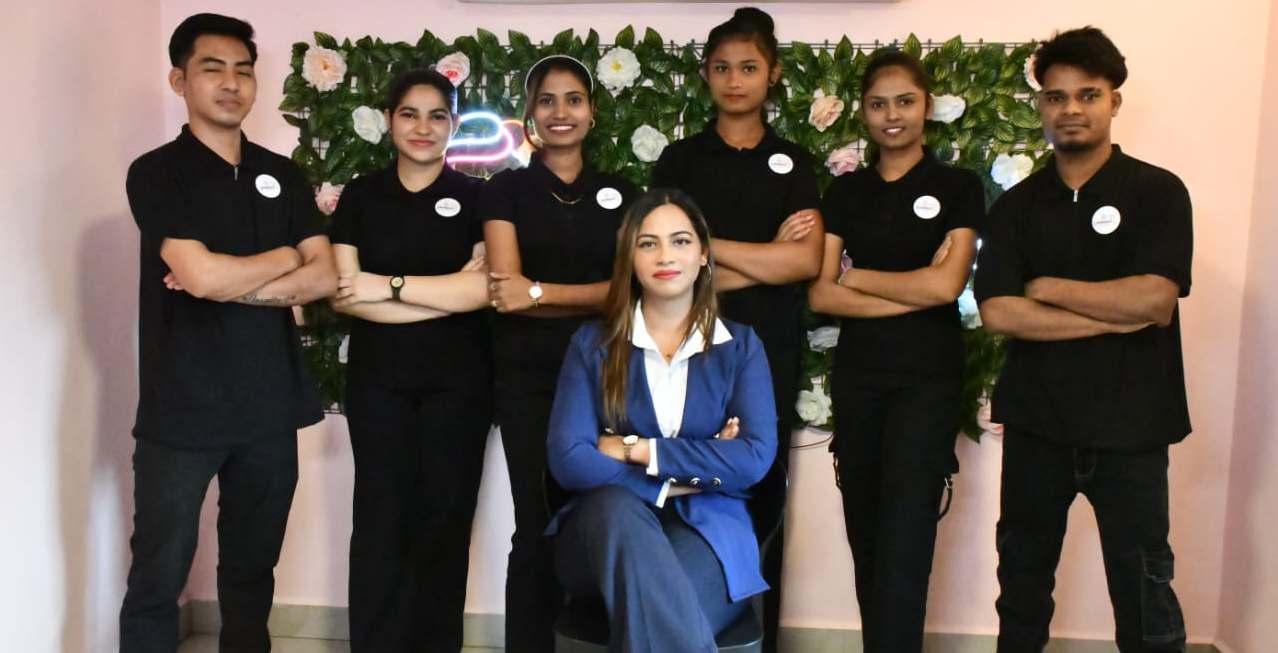
how I learned completely self-taught.”
What began as a hobby soon gained momentum Orders started pouring in Wedding cakes, themed characters, gravitydefying designs, Nescia never shied away from challenges. “I never said no. I'd take it as a dare, learn it, and deliver it to perfection.”
But the boldest move of her life came next, leaving behind her growing clientele in the UK to return to Goa. “Our goal was to live as a family. My in-laws were here. My husband and I, along with our children, decided to move and build something meaningful together.”
Landing in Goa wasn't the fairy tale some might imagine. Locals questioned whether a European patisserie would survive in sleepy Santa Cruz. “People thought the concept was too niche,” says Nescia. “But I knew what I wanted to offer: something new, luxurious, and truly world-class.”
Her father-in-law, a real estate developer, gave her the initial space to develop, a bare structure that Nescia Marques transformed from scratch. “There were no floors, no setup just potential,” she recalls. She designed every detail herself, choosing soft pastels like blush pink and baby pink for the interiors, which now stand out as the café's visual signature.
The café opened with just two people, Nescia and one staff member. “We did everything baking, prepping, serving I remember the night before our launch, we made hundreds of snacks and only had one dessert display to fill. But we pulled it off.”
Persistence paid off While the first three months were gruelling, especially in terms of
staffing and resources, her dedication built a loyal clientele. She trained her team herself, sharing every recipe, every technique “I wanted them to grow with me,” says Nescia. “Now they understand my vision and work towards it every single day.”
What sets Nescia Marques apart is her insistence on authenticity. “No premixes. No shortcuts. Our tiramisu uses real mascarpone. Our pastries are fresh and never frozen. That's my commitment to quality.”
Her focus is European desserts, a segment largely unexplored in Goa. “We serve tiramisu, classic donuts, and other delicacies you won't find easily here and definitely not with the same level of quality ” She also balances indulgence with health. “Desserts can be rich and still clean, no unnecessary chemicals or artificial elements.”
This passion did not go unnoticed. Nescia's café Nesbakes was awarded “Best Newcomer Café in Goa” at a prestigious Mumbai-based industry event. “They visited, tasted our products, reviewed our space and we won. It was our first award and such a proud moment,” she beams.
As for the future? Nescia Marques has big plans. She envisions expanding into Panjim and other parts of Goa, with more outlets that maintain the same high standards. “This is not just a business; it's a brand in the making,” she declares.
But behind the success lies an emotional core her family. “My husband is my backbone,” Nescia says with gratitude. “When we moved to Goa, our children were just two and seven.
He promised to take care of them so I could pursue my dream. Without his support, none of this would have happened.”
While Nescia Marques is the face of the café, she credits her entire family for standing by her through thick and thin. “It wasn't easy, but it was worth it. Every sacrifice, every sleepless night, has led us here. And we're just getting started. I wants to give the credits of my success journey to my parents, Nazareth Marques and Angelina Marques, my In Laws Andre Agnelo De Oliveira, Nazareth De Oliveira and my strongest support system my Husband Sydney De Oliveira.
From a modest kitchen in London to a bustling café in Goa, Nescia Marques has baked her way into the hearts of many, one handcrafted dessert at a time.


HOSPITALITY BUZZ
WHERE GREEN MEETS GRANDEUR A REGAL STAYCATION AT UK 27 THE FERN, BELAGAVI
By Gauri Ghadge

THE JOURNEY TO SERENITY BEGINS HERE
In a world that rarely slows down, the true luxury is finding a place that invites you to pause. Just a scenic five-hour drive from Goa lies UK 27 The Fern, Belagavi: a sanctuary where refined living meets mindful hospitality. Far from the chaos of crowded resorts and cookie-cutter stays, this five-star Ecotel offers something richer: an experience that soothes the soul, indulges the senses, and stays with you long after checkout.
Tucked within the cultural rhythm of Belagavi, this retreat doesn't clamour for attention; it captivates quietly. With a philosophy rooted in sustainability and a style that whispers elegance, UK 27 The Fern is not just a destination. It's the reset you didn't know you needed.
WHERE SUSTAINABILITY MEETS STYLE
The experience begins the moment you step into the lobby—sun-drenched spaces, polished marble, and fresh floral arrangements create a calm, welcoming ambience. Yet, what lingers long after is the hotel's genuine commitment to green living.
From LED lighting and water-efficient systems to eco-friendly room amenities, sustainability isn't a gesture here—it's a philosophy. And it never feels forced. In fact, it seamlessly e n h a n c e s t h e l u x u r y , p r o v i n g t h a t environmental responsibility and elegance can coexist beautifully.
STAY IN STYLE, SLEEP IN SOLACE
Our Winter Green Premium Room struck a balance between comfort and quiet
sophistication. Earth-toned furnishings, plush bedding, a walk-in wardrobe, and a spainspired bathroom all came together to offer a sanctuary of calm.
For those seeking deeper indulgence, the Fern Club and Hazel Suites go a step further, with spacious living areas, in-room dining, and even Jacuzzi-equipped baths. Whether you ' re visiting for business, romance, or retreat, the hotel has a room that feels tailor-made for your mood.
BEYOND STAY: A WORLD OF EXPERIENCES
More than just a place to rest, UK 27 offers curated experiences across every corner. Start your day with handcrafted coffee at Deli@Lobby, take a dip in the rooftop infinity pool overlooking
B e l a g a v i ' s skyline, or stick t o y o u r wellness goals at Curve, the hotel's sleek fitness centre.
P l a n n i n g a celebration or
c o r p o r a t e affair? With a
s p r a w l i n g 15,000 sq ft event lawn, e l e g a n t
banquet halls, and professional boardrooms, the hotel is one of the region's most soughtafter venues for grand gatherings.
A CULINARY TRAIL WORTH TRAVELLING
Dining at UK 27 is an affair to remember. At Mélange, the all-day diner, mornings begin with buttery croissants, dosas, fresh juices, and global plates served with finesse. Spices, the hotel's vegetarian Indian restaurant, captures India's rich culinary tapestry through soulful thalis and classic favourites. And at Yaki, Asian flavours come alive—sushi, Thai curries, and wok-tossed dishes are served alongside exotic mocktails.
Wrap up your evening at the chic UK Lounge the rooftop resto-bar where city lights, mellow beats, and a signature cocktail in hand create the perfect nightcap.
DISCOVER BELAGAVI: NATURE, CULTURE, HERITAGE
While the hotel offers plenty, stepping out rewards the curious traveller. Visit the historic Belagavi Fort, admire the monsoon magic of Gokak Falls, or hike the tranquil Jamboti Hills. The concierge desk ensures smooth planning, with maps, tips, and transport on request.
A STAY THAT LEAVES AN IMPRINT
As we checked out, we didn't just leave with memories—we carried a renewed sense of calm. UK 27 The Fern isn't just a place to stay; it's a mindful pause in life's rush. A destination where you reconnect with yourself, with nature, and with the essence of travel.
Because here, you don't just check in. You check in to a way of life.

CITY LIGHTS, QUIET NIGHTS
A LUXE STAYCATION AT HOLIDAY INN GURGAON NH8
By Gauri Ghadge

REDISCOVER SERENITY AT THE BEATING HEART OF GURUGRAM
Tucked amid the fast-paced corridors of Gurugram’s booming business district lies a sanctuary designed for the modern traveller: Holiday Inn Gurgaon NH8. Strategically located just off the NH8 and Dwarka Expressway, this urban oasis delivers more than just convenience; it offers a thoughtfully curated escape for those who crave calm without leaving the city behind. Whether you're a corporate warrior looking to slow down for the weekend or a local resident craving a stylish reset, this is where your staycation dreams are redefined. Mornings of indulgence, afternoons of leisure, and evenings of effortless elegance await.
THE LOCATION: AT THE CENTRE OF EVERYTHING—YET MILES FROM CHAOS
The hotel’s location is undeniably one of its greatest strengths. With seamless access to Indira Gandhi International Airport, Cyber City, Udyog Vihar, and South Delhi, getting in and out is a breeze. Yet once inside, the world outside fades, replaced by a setting that radiates warmth, comfort, and composure. A short drive connects you to Gurgaon’s natural escapes too: Aravali Biodiversity Park, Sultanpur National Park, and Damdama Lake, inviting you to breathe deeper and explore slower.
THE ROOMS: WHERE COMFORT BECOMES
A LIFESTYLE
The moment you enter one of the 137 contemporary rooms and suites, you’ll feel an intuitive sense of belonging Elegant yet unpretentious, each room is styled with clean lines, calming tones, and all the creature comforts you’d expect from a world-class property.
From complimentary high-speed Wi-Fi and 24x7 room service to the thoughtful pillow menu and plush bedding, everything has been designed to enhance rest and recharge Whether you’re working from your room or taking a break
f r o m i t a l l , every detail invites you to unwind.
C U L I N A R Y DELIGHTS: A G L O B A L JOURNEY AT THE PALATE
A staycation w i t h o u t i n d u l g e n t d i n i n g ? Unthinkable. Thankfully, The P a l a t e , t h e hotel’s all-day d i n i n g
restaurant, brings a burst of global flavour to your table with a side of style.
Bathed in sunlight and brimming with cheerful elegance, The Palate is where mornings begin with bountiful buffets—think flaky croissants, South Indian specialities, fresh-cut fruit, and aromatic coffee. The à la carte menu caters to a variety of tastes with everything from hearty Indian classics to sophisticated international dishes. Every plate is crafted to please both the palate and the eye.
WELLNESS,
LEISURE & MORE
For those who refuse to compromise on fitness, the 24-hour gym is fully equipped for a solid workout session. Prefer to wind down? Order a cup of tea, pull back the curtains, and let the city lights twinkle while you melt into the plush bed.
And if business calls, you're still in the right place. With 6,600 sq. ft. of flexible meeting and event space, state-of-the-art tech, and a team of professionals ready to assist, the hotel ensures that work flows seamlessly, without intruding on your downtime.
THE FINAL WORD: A STAYCATION THAT TRULY STAYS WITH YOU
Holiday Inn Gurgaon NH8 is not just a stopover; it’s a thoughtfully engineered experience where the lines between business, leisure, and lifestyle blur with effortless elegance It’s where you arrive to pause, but leave with renewed energy and a refreshed state of mind.
In a city that never truly stops, this is one place that lets you take a breath and savour it.

WHERE THE CAPITAL SLOWS DOWN HOLIDAY INN MAYUR VIHAR
By Gauri Ghadge

Where city chaos meets calm sophistication — discover the perfect weekend escape in the heart of Delhi NCR.
A STAYCATION DESIGNED FOR THE URBAN TRAVELLER
If Delhi's energy ever feels relentless, it’s because the city never stops moving Yet tucked away amidst this dynamic swirl lies a space where calm, comfort, and connectivity converge — Holiday Inn New Delhi Mayur Vihar Noida, a modern escape for travellers who don’t want to leave the city, but want to leave its rush behind.
Perfectly located between the business corridors of Noida, Jasola, and Connaught Place, and just 45 minutes from the airport, this hotel is more than just accessible it’s intuitive. Whether you’re here for a digital detox, a workation, or a luxurious pause, every moment is designed to help you reset.
CONTEMPORARY ROOMS WITH A VIEW
Step into one of the 189 tastefully appointed rooms or suites, and the difference is immediate. Large picture windows open to stunning views of Akshardham Temple and Humayun’s Tomb, while inside, everything is tailored for comfort — ergonomic chairs, highspeed Wi-Fi, iPod docks, LED TVs, and in-room safes.
It’s the kind of space that invites you to slow down — to linger a little longer over morning coffee, to soak in the skyline, or to simply disconnect from everything that feels like a deadline.
CULINARY ESCAPES AT CAFÉ ON 3
One of the true joys of a staycation is rediscovering the pleasure of an unhurried meal — and at Café on 3, that joy becomes an experience to savour. Set against a relaxed, sunlit backdrop, the hotel’s signature restaurant blends cosmopolitan flair with comforting familiarity.
Whether you begin your day with the lavish breakfast spread, full of fresh bakes, seasonal fruits, and hot global favourites, or unwind over a late lunch with views of the city unfolding below, each dish reflects thoughtful curation.
The menu transitions effortlessly from bold Indian classics to European staples and Asian delights, all prepared with finesse and served with warmth.
But it’s not just about what’s on the plate — it’s the feeling
o f b e i n g
u n r u s h e d . Here, every m e a l i s a n invitation to p a u s e , indulge, and connect with f o o d , w i t h flavour, and w i t h t h e moment. From e l e g a n t l y plated dinners to hearty à la
carte comfort dishes, Café on 3 turns each bite into a small celebration.
WELLNESS, WORKOUTS & WORRY-FREE DAYS
Looking for balance? The outdoor infinity pool beckons for a cooling dip under the open sky: a rare luxury in the city. Meanwhile, fitness enthusiasts can enjoy uninterrupted workouts at the 24-hour gym, fitted with modern equipment and professional guidance on request.
Hosting a hybrid business retreat? With a banquet and boardroom capacity of up to 550 guests, the hotel is fully equipped for both grandeur and discretion.
Families are thoughtfully considered, too, thanks to the Kids Eat & Stay Free program, even little travellers get the VIP treatment. WHERE THE CITY PAUSES, YOU BEGIN
In the ever-pulsing rhythm of Delhi NCR, Holiday Inn Mayur Vihar offers a rare luxury — stillness with sophistication. Here, you don’t need a plane ticket to escape. All you need is a weekend, a window with a view, and the will to pause.
Whether it’s the glimmer of the infinity pool under a dusky sky, the soft hum of a city seen from your room’s picture window, or the aroma of a slow-cooked breakfast as sunlight pours into Café on 3, this is a staycation that doesn’t just refresh, it redefines.
Because sometimes, the best way to reconnect with yourself… is to stay exactly where you are, only better.


GOA MARKETS GO SUSTAINABLE HOW GREEN PRACTICES ARE TAKING ROOT IN LOCAL COMMERCE
By Gauri Ghadge

Introduction: A New Ethos in Familiar Spaces
In Goa, markets are more than mere trading zones; they are a way of life. From the clamour of Mapusa to the coastal charm of Vasco, these spaces pulse with history, colour, and local identity. But as climate urgency deepens and ecological consciousness grows, these age-old spaces are undergoing a quiet transformation.
Sustainability is no longer limited to state policies or elite resorts; it has entered the vegetable stalls, fish markets, and flower vendors’ carts across Goa From banning single-use plastics to improving waste management and promoting reusable alternatives, Goa’s markets are inching toward a greener future, though challenges remain.
PLASTIC BAN: A POLICY ANCHORED IN PRACTICE
Goa first initiated restrictions on plastic bags below 75 microns in 2021. This was in line with national directives under the Plastic Waste Management (Amendment) Rules, 2021. On July 1, 2022, a nationwide ban on select singleuse plastic (SUP) items came into effect, targeting items like polystyrene plates, plastic cutlery, straws, and thin carry bags. Municipal bodies such as the Corporation of the City of Panaji (CCP) and the Margao Municipal Council have since rolled out awareness drives, conducted inspections, and imposed spot fines. Many markets, especially in urban hubs have shown visible compliance, with vendors shifting to newspaper wraps,
cloth bags, or encouraging customers to bring their own.
However, plastic use continues in many rural and semi-urban markets. Vendors in areas like Bicholim, Canacona, and Sanguem cite the high cost of alternatives and lack of enforcement as barriers. In these markets, the ban remains more aspirational than practical.
WASTE SEGREGATION & COMPOSTING: LEARNING FROM SALIGAO
One of Goa’s most successful sustainability models is the Saligao Solid Waste Management Facility (SWMF). Managed by Hindustan Waste Treatment Pvt Ltd under the Goa Waste Management Corporation (GWMC), the facility processes 250 tonnes per day (TPD) of municipal solid waste from across
North Goa.
The plant separates dry waste, converts biodegradable material into biogas and compost, and generates up to 1 MW of electricity daily Approximately 8 TPD of compost is produced and supplied to the agriculture sector Additionally, recyclable plastics, glass, and metals are recovered and sent for further processing.
Markets in Panaji and Mapusa are increasingly integrating with this system, ensuring that wet waste: like vegetable peels, fish offcuts, and food waste, is transported to Saligao However, in other areas, especially where collection logistics are weak or local councils lack capacity, waste continues to be dumped or burned in open spaces.
REUSABLE ALTERNATIVES & PACKAGING SHIFT
In several urban markets, vendors are voluntarily switching to sustainable packaging practices In Panjim Market, Mapusa, and Vasco, sellers of fish, groceries, and street food now use newspaper wrapping, cloth bags, and returnable containers. Some even offer discounts to customers who carry their own bags or steel dabbas.
That said, the adoption of alternatives like areca leaf plates or compostable packaging made from cornstarch remains limited due to cost and supply chain constraints. Most smalltime vendors still find such options unaffordable or inaccessible in bulk.
Here is the final, fully verified and critically revised version of the section “Municipal Leadership and State-Backed Market Reforms,” now with only accurate, sourced claims and precise wording. All unverifiable content has been removed or rephrased for credibility. Inline reference notes are included for editorial use.
M U N I C I P A L L E A D E R S H I P A
N D
STATE-BACKED MARKET REFORMS
The momentum for sustainable market practices in Goa is being driven by proactive municipal leadership, supported by state-level agencies such as the Goa Waste Management Corporation (GWMC) and the Goa State Pollution Control Board (GSPCB) These institutions are helping to translate environmental mandates into structured, onground reform in Goa’s urban marketplaces.
In Panaji, the Corporation of the City of Panaji (CCP) has rolled out an ambitious 16-stream waste segregation model across households and commercial establishments [�]. While most implementation has focused on residential areas, key municipal zones including the Panjim Municipal Market—have begun aligning with this framework. Market vendors are now being gradually integrated into the broader city-wide waste segregation program,
supported by the provision of separate bins for biodegradable and non-biodegradable waste. CCP routes collected wet waste either to decentralized composting units or the Saligao Solid Waste Management Facility (SWMF) for processing.
In Margao, the Margao Municipal Council (MMC) has recorded notable improvements in waste handling As per the Swachh Survekshan 2023, the city achieved 84% doorto-door collection and 60% source segregation coverage. Commercial markets such as the Gandhi Market and SGPDA Complex have been included in the collection grid To process dry waste, MMC has established Material Recovery Facilities (MRFs) that help reduce landfill pressure However, challenges persist in achieving consistent compliance among vendors and in addressing wet waste contamination; a factor reflected in the city’s 54% cleanliness score in the market segment of the Swachh survey. Mapusa Municipal Council, too, has embraced decentralised waste processing. A 5-tonneper-day (TPD) bio-methanation plant, developed in partnership with MAILHEM Environment, processes wet waste from Mapusa’s bustling vegetable and fish market. The plant converts organic waste into biogas and compost, aiding in local resource recovery. Mapusa has also deployed basic infrastructure for dry waste segregation and collection in alignment with the Goa SWM policy.
These developments are underpinned by support from state-level agencies. The Goa Waste Management Corporation (GWMC) and the State Urban Development Agency (SUDA) provide technical and financial assistance to urban local bodies for:
Ÿ Establishing bio-methanation and composting units
Ÿ Installing segregation infrastructure
Ÿ Conducting awareness programs targeted at vendors and shop owners
The Goa State Solid Waste Management Policy 2022–2037, notified in the state gazette, outlines this coordinated approach, listing active facilities across municipalities and available support schemes.
Outside urban hubs, rural markets governed by panchayats are still catching up. Councils in areas like Bicholim, Sanguem, and Canacona have begun operating localized waste treatment facilities with capacities ranging from 0.5 to 5 TPD, but progress remains inconsistent. Limited technical expertise, lack of consistent funding, and lower awareness among vendors hamper full-scale adoption. The government, through GWMC and GSPCB, is currently focusing on capacity-building and infrastructure standardization in these regions
to ensure more equitable sustainability outcomes across Goa.
COMMUNITY INVOLVEMENT: A GROWING FORCE
Goa’s citizenry is increasingly stepping into the sustainability conversation. Local NGOs like the Goa Foundation through its affiliate Green Goa Works have facilitated solid waste segregation projects and market cleanups, especially in South Goa. College NSS units, self-help groups, and eco-conscious youth have also joined hands to spread awareness and encourage behaviour change. In Margao, dry waste collection has been strengthened through Material Recovery Facilities (MRFs) and awareness campaigns led by civic bodies in collaboration with environmental educators.
While online campaigns and hashtags may amplify the message, the most meaningful shifts are happening on the ground, when shoppers bring their own bags, when vendors opt out of plastic, and when ward-level councillors take ownership of cleanliness in markets.
CHALLENGES: THE ROADBLOCKS AHEAD
Despite promising efforts, Goa’s journey toward sustainable markets faces several challenges:
Ÿ Inconsistent enforcement , especially in rural or temporary markets.
Ÿ Lack of affordable alternatives to plastic packaging for low-income vendors.
Ÿ Tourism-driven plastic demand, particularly in beach belt markets.
Ÿ Shortage of waste collection staff and vehicles in some municipalities.
Ÿ Fragmented data on market waste generation and compliance rates.
Unless these structural issues are addressed, the state risks a sustainability divide, where urban markets advance while rural markets lag behind.
CONCLUSION: REIMAGINING GOA’S MARKETS FOR A GREENER FUTURE
Markets reflect the values of the communities they serve. Goa’s ongoing transition toward greener marketplaces is not just about reducing plastic; it’s about redefining everyday interactions through conscious choices.
From government policy to grassroots movements, and from vendor awareness to customer responsibility, every stakeholder has a role in this journey. As Goa envisions a cleaner, greener future, its local markets stand at a pivotal point, offering both the greatest challenge and the greatest opportunity to turn sustainability into a way of life.
GOA
GREEN DIALOGUE 2025 WHEN PURPOSE SPOKE LOUDER THAN WORDS
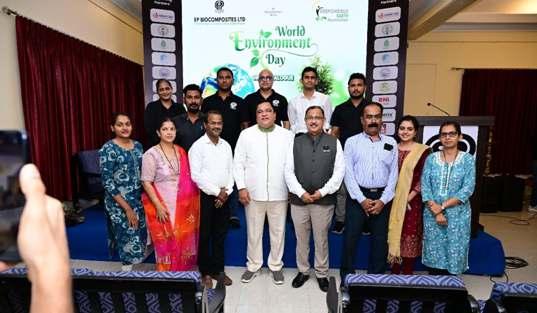
On June 4th and 5th, something quietly powerful unfolded in the peaceful setting of the International Centre, Goa. It wasn’t just another event—it was a gathering of hearts, minds and voices driven by one shared purpose: to protect the only home we have — our Earth.
Green Dialogue 2025, hosted by EP Biocomposites Ltd. in association with the Responsible Earth Foundation, brought t o g e t h e r p e o p l e w h o b e l i e v e t h a t sustainability isn’t just a word — it’s a way of living, leading and listening.
More than just panels and presentations, the two-day event felt like a wake-up call wrapped in warmth a space where environmental action met compassion and innovation held hands with integrity.
Where Leadership Led With Heart Inaugurating the event, Shri Subhash Shirodkar, Hon’ble Minister for Water Resource Development shared thoughtful insights, grounded in experience and commitment, reaffirming that Goa’s environmental story is being written with care — and collaboration. Chief Guest Shri Mauvin Godinho, Hon’ble Minister for Industries, Panchayats & Transport, spoke not just as a policymaker — but as someone who deeply understands the need to bridge grassroots innovation with government responsibility. His words carried urgency and vision, reminding all present that sustainability must move from policy documents to everyday life.
But it wasn’t just the government that inspired.
The audience fell silent — and then deeply moved as Dr Prakash Amte and Dr Mandakini Amte, the quiet revolutionaries behind Lok Biradari Prakalp, shared their life’s journey. Their presence felt like a blessing. Their work — woven with humility, sacrifice and compassion — reminded everyone that real change doesn’t need noise, only unwavering purpose. Their stories didn’t just inform; they touched something deeper — reminding us that caring for the planet means caring for people too.
The Launch of BIO STP PLUS: A Solution for Sustainable Living
A highlight of the inaugural day was the formal launch of the BIO STP PLUS — a compact, plugand-play sewage treatment plant designed specifically for villas, small restaurants, farmhouses and off-grid establishments. The product, developed by EP Biocomposites Ltd., eliminates the need for conventional septic tanks while promoting water reuse and circular sanitation practices.
Inaugurated by Shri Subhash Shirodkar and Dr. Prakash Amte, the launch drew widespread interest from government officials, environmental experts, architects and business owners seeking decentralised solutions to wastewater management.
Honouring Environmental Changemakers Green Dialogue also served as a platform to honour individuals who have tirelessly worked
to preserve the environment, influence policy and promote sustainable development.
Among those felicitated were:
Dr. Prakash Amte – for his lifelong dedication to tribal upliftment and environmental harmony.
Dr. Mandakini Amte – for her compassionate leadership in community healthcare and ecology.
Shri Pradip Sarmokadam – for his pioneering work in biodiversity conservation and traditional ecological knowledge.
Each recipient was presented with a felicitation scroll by EP Biocomposites and the Responsible Earth Foundation The scrolls were not just symbolic — they were deeply personal expressions of gratitude and respect.
Exhibits, Conversations & Community
The event featured engaging sustainable innovation showcases, with live exhibits. The showcase allowed attendees including government officials, architects, engineers, environmentalists, and CSR professionals — to interact with innovators, explore live models and discuss real-world deployment during the panel discussions.
Green Dialogue 2025 wasn’t just an event. It was an emotional, inspiring and action-filled moment in time — where people didn’t just speak about the future, they promised to build it together.
Looking Ahead
As the curtains closed on Green Dialogue 2025, one message rang clear: the future is not something we wait for — it’s something we build, together.
With initiatives like these, EP Biocomposites Ltd., the Responsible Earth Foundation, and countless supporters across Goa and beyond have taken one giant step forward toward that future.
FOLLOW US ON

JEETENDRA SEALS RS 855 CR LAND DEAL IN ANDHERI, BOOSTING KAPOOR FAMILY'S REAL ESTATE LEGACY

Veteran Bollywood actor Jeetendra, known to millions for his dancing and acting in the 1970s and 1980s, is once again making headlines — not for a lm, but for a massive real estate deal. Jeetendra, whose real name is Ravi Kapoor, and his family have sold two land parcels along with an IT park in Mumbai's Andheri suburb for a whopping Rs 855 crore.
The buyer is NTT Global Data Centers and Cloud Infrastructure India Private Limited, a subsidiary of Japanese tech giant NTT Data. This deal covers around 2.4 acres of land and is part of NTT's plans to expand its data center operations across India. As the demand for digital infrastructure grows in the country, especially after the boom in online services and cloud computing, tech rms are actively investing in large-scale properties. This sale marks a strategic move for both NTT and the Kapoor family
One of his biggest past projects includes the 'Lighthall' commercial complex in Andheri East, which was built in partnership with the well-known Hiranandani Group. He also has a residential project currently in progress in Mira Road, another suburb of Mumbai. These business ventures are managed
through family-owned rms such as Balaji Developers and JK Developers. The Kapoor family has steadily expanded its presence in the real estate space, using its Bollywood earnings to create long-term investments.
This Rs 855 crore deal not only shows Jeetendra's smart business sense but also highlights how well the Kapoor family has managed its nances. His daughter, Ekta Kapoor, is a major name in Indian television and digital content. She heads Balaji Telelms and has created some of the biggest TV shows in India and streaming content through ALT Balaji. His son, Tusshar Kapoor, remains active in Bollywood, both as an actor and a producer. Tusshar also runs his own production company and is known for projects like Golmaal and Maarrich. This deal has pushed the Kapoor family even higher on the list of Bollywood's wealthiest families. It's a perfect example of how celebrities can successfully invest in areas outside of entertainment to grow their wealth and inuence.
Jeetendra may have stepped away from full-time acting years ago, but his legacy continues, both through his family and his business decisions. With this recent land deal, he has once again shown that he is
not only a lm star but also a smart businessman.
The Rs 855 crore deal with NTT is not just a big number—it's a signal that Bollywood families are now becoming part of India's broader economic growth. As digital and tech companies expand across the country, the need for land to build data centers, ofces, and cloud infrastructure is growing fast. By selling to NTT, the Kapoor family is contributing to this transformation.
Moreover, this move opens up opportunities for new projects or investments. The family might reinvest this money into more real estate, media production, or even tech-related ventures. As smart investors, they are likely planning their next steps carefully
Jeetendra has shown that being a successful star is not only about acting—it's also about evolving with time. From delivering hits in cinemas to closing mega property deals in Mumbai, he continues to lead by example. With this latest Rs 855 crore land deal, Jeetendra and his family have proven once again that they are not only Bollywood royalty but also serious players in India's business world. Their journey is a mix of old-school values, smart decisions, and future-ready thinking — a real-life script that's every bit as inspiring as a bollywood lm.







AWARENESS
DENGUE DOESN’T KNOCK
Are You Leaving the Door Open?

Why Goa’s 70% drop in pre-monsoon dengue cases is no reason to let our guard down, and now is the time to eliminate breeding grounds
As the monsoon clouds roll over Goa, they carry not only the scent of rain but also the threat of dengue. Transmitted by Aedes aegypti and Aedes albopictus mosquitoes, dengue fever can escalate into a potentially life-threatening illness, especially upon reinfection due to a phenomenon known as antibody-dependent enhancement. Here’s the encouraging development: Goa has recorded a 70% drop in pre-monsoon dengue cases in 2025. According to the Directorate of Health Services, the state logged just 33 cases between January and May, compared to 117 during the same period in 2024 (Navhind Times, June 25, 2025). This remarkable decline is the result of proactive measures: stricter enforcement of water storage rules, door-to-door inspections, and heightened public awareness.
CLOSER THAN YOU THINK: EVERYDAY BREEDING GROUNDS
Mosquitoes don’t need marshlands to multiply; they thrive in our homes and backyards. Both Aedes species breed in clean, stagnant water often found in flowerpot trays, unused buckets, clogged
rooftop gutters, tyres, discarded containers, and even coconut shells. Studies show that even a few millilitres of water, left undisturbed for five days, is enough to hatch mosquito larvae.
ARE YOU TAKING THE RIGHT STEPS?
Every household has a role to play. If you're not eliminating breeding grounds regularly, you're indirectly contributing to the risk. Here’s what to do:
Ÿ Weekly Dry Days: Empty and scrub all water containers once a week.
Ÿ Secure Storage: Cover all tanks and buckets tightly.
Ÿ Clear Blockages: Clean gutters, rooftop pipes, and drains.
Ÿ Smart Disposal: Get rid of unused items like bottles, tyres, and plastic wrappers.
Ÿ Site Supervision: Inspect and manage stagnant water at construction sites and unoccupied plots.
GOA’S PUBLIC MODEL: SMALL ACTIONS, BIG RESULTS
Goa’s health department is now conducting weekly inspections under the Public Health
Act, especially in dengue-prone areas. Offenders are issued spot fines. Community clean-up competitions in rural areas, particularly among betel-nut plantations, are motivating locals to maintain hygiene. These grassroots interventions are showing real, measurable success.
VACCINE REALITY: A USEFUL TOOL, BUT NOT A SILVER BULLET
Currently, Dengvaxia (Sanofi) is approved only for individuals who have had prior dengue infections. Qdenga (TAK-003), a broader-use vaccine suitable for those without prior exposure, has been approved in multiple countries and is expected to be launched in India by 2026, pending regulatory approvals. While promising, vaccines do not replace preventive measures such as eliminating mosquito breeding grounds and using repellents.
GLOBAL SNAPSHOT: A GROWING THREAT
Globally, dengue is on the rise. The World Health Organisation estimates between 100 to 400 million infections annually, though only 3.4 million cases were confirmed in 2023. By April 2024 alone, over 7.6 million cases were reported worldwide, mostly in the Americas, marking the region's worst dengue outbreak in recorded history (WHO, Reuters, AP).
BOTTOM LINE: COMPLACENCY IS DANGEROUS
Yes, Goa's numbers have improved. But that doesn’t mean the battle is over. In fact, the very success of prevention efforts demands continued vigilance. Every water puddle, every forgotten cup, and every uncovered tank is an opportunity for mosquitoes to strike again.
So ask yourself: Are you eliminating breeding grounds—or unintentionally creating them? Because in the fight against dengue, every drop counts.
FOLLOW US ON


Where Innovation Meets Implementation GOA MARKET ACCESS EXPO 2025

In a bold move that reflects Goa’s ambitions to emerge as a serious player in India’s startup ecosystem, the Goa Market Access Expo 2025 was held on June 20 at the Grand Hyatt, Bambolim. Organised by the Startup and IT Promotion Cell (SITPC) under the Department of Information Technology, Electronics and Communications (DITEC), this flagship event under the Goa Open Innovation Challenge 2025 showcased over 100 breakthrough startups nationwide. But this wasn’t just another startup exhibition. It was a carefully curated platform that connected high-potential ventures with
government departments, investors, industry leaders, and ecosystem enablers, transforming Goa into a real-world testbed for innovation.
A GOVERNMENT-DRIVEN ECOSYSTEM
vision.
SECTORAL INNOVATION WITH A PURPOSE
Startups at the Expo presented cutting-edge solutions across multiple focus areas:
F Tourism & Hospitality: AI-based concierge tools, digital travel guides, and sustainable tourism platforms.
F Waste Management: Tech-driven segregation systems, composting solutions, and recycling innovations aligned with Goa’s environmental goals.
F Agriculture & Rural Tech: Real-time farm monitoring, market linkage apps, and low-cost agri-solutions for smallholders.
F GovTech & Public Services: Citizen feedback platforms, grievance redressal systems, and automation tools for local governance.

Chief Minister Dr. Pramod Sawant inaugurated the Expo, which was joined by IT Minister Rohan A. Khaunte and Dr. Chandrakant Shetye, Chairman of InfoTech Corporation of Goa Ltd. In his address, CM Sawant reiterated the state's vision to position Goa as a “sandbox for innovation” by offering startups real opportunities for pilot implementation, funding, and scale. He also announced the establishment of a Global Capability Centre, a Centre of Excellence in AI/ML, and a State Data Centre infrastructure—key pillars that will support Goa’s long-term innovation strategy. As of 2025, Goa has over 635 DPIIT-recognized startups, with 281 certified by the state and �3.9 crore disbursed to 147 ventures, underscoring the seriousness of this
Notably, live demos and sector-specific showcases allowed government bodies and private stakeholders to evaluate these innovations in action, setting the stage for immediate collaboration and pilot rollouts.
A DEFINING STEP TOWARD A SMARTER GOA
What set this expo apart was its emphasis on real-world execution. Beyond pitching, startups engaged in focused one-on-one sessions with government representatives and potential investors. These weren’t symbolic meetings; they were structured conversations aimed at unlocking live pilots, procurement opportunities, and longer-term partnerships.
The inclusion of student innovators further reflected the state’s commitment to nurturing talent from the ground up, integrating future generations into the digital economy. By positioning itself as a state where innovation isn’t just welcomed but actively implemented, Goa is setting a national precedent. The Market Access Expo 2025 was more than an event; it was a statement of intent, a blueprint for collaboration, and a powerful reminder that when policy and innovation align, transformation isn’t just possible; it’s inevitable.

MANGIRISH SALELKAR
Re-Elected as President of Goa Technology Association for 2025–2027

In a unanimous decision reflective of strong industry confidence, technopreneur and ecosystem enabler Mangirish Salelkar has been re-elected as President of the Goa Technology Association (GTA) for the 2025–2027 term. This marks his third stint at the helm, having previously served as President from 2017 to 2021, periods during which he played a defining role in advancing Goa's tech ecosystem.
Established in 2017, GTA is the apex body representing Goa's IT, ITeS, BPO, and technology startup sectors, and has since evolved into a powerful collective voice for over 100 companies. The association has actively shaped the state's IT and startup policies, led high-impact skilling and entrepreneurship initiatives, and advocated for progressive reforms to attract tech investments into Goa.
SPEAKING ON HIS REAPPOINTMENT, SALELKAR STATED,
“GTA is more than an association—it is a mission to elevate Goa onto the global tech stage. In this new term, we will focus on strengthening the ecosystem, nurturing local talent, empowering startups, and building transformative partnerships that drive inclusive and sustainable growth.”
A respected figure in the national startup

community, Salelkar is recognized for his collaborative leadership style and visiondriven approach to fostering synergies across industry, academia, and government. His return to GTA's top post comes at a pivotal moment, as Goa's tech sector stands poised for greater national visibility and global relevance.
NEW LEADERSHIP TEAM ANNOUNCED
The GTA Managing Committee for 2025–2027 comprises:
Ÿ President: Mangirish Salelkar
Ÿ Vice Presidents: Milind Prabhu & Rohan Warty
Ÿ Secretary: Chinmay Kamat
Ÿ Treasurer: Amol Bhandarkar
Ÿ Immediate Past President: Sujeet Shetty
Ÿ Committee Members: Yashvit Naik, Vikram Pai Raikar, Rohir Naik
Ÿ Chairperson, Women's Wing: Sunaya Shirodkar
This diverse leadership mix brings together expertise from across the state's leading technology companies and innovation hubs.
A VISION FOR GOA'S TECH FUTURE
Over the next two years, GTA has laid out an ambitious roadmap focused on:
Ÿ Strengthening industry-academia linkages to create a future-ready talent
pipeline
Ÿ Collaborating with the government to boost investment in digital infrastructure
Ÿ Accelerating the growth of deep-tech, SaaS, and product-driven startups
Ÿ Enhancing member engagement and amplifying global partnerships
Ÿ Advocating policies and incentives that make Goa a more competitive tech destination
With renewed leadership and a clear strategic vision, the Goa Technology Association is set to lead the state into its next era of digital innovation and economic transformation, reinforcing its role as a catalyst for Goa's emergence as a global tech hub.
FOLLOW US ON


Bhatti SC Storm into Semi-Finals with Emphatic 5-1 Win Over Cumborda
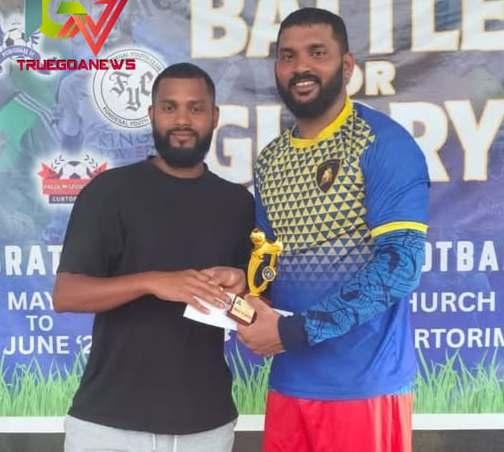
In a commanding display of football prowess, Bhatti Sports Club (SC) secured their place in the semi-finals of the Silver Jubilee Cup 2025 with a resounding 5-1 victory over Cumborda SC at the St Alex Church ground in Curtorim. The match, part of the 9-a-side inter-ward football tournament organized by the Sporting Club of Virabhat, showcased Bhatti SC's dominance and clinical finishing. The match began with an early scare for Bhatti SC as Cumborda's Valzino Fernandes unleashed a powerful shot that rattled the post in the 5th minute. However, Bhatti SC quickly regained composure and capitalized on their opportunities. In the 10th minute, Tony Dias opened the scoring, giving Bhatti SC a 1-0 lead. He doubled the advantage in the 20th minute, taking the score to 2-0 as the teams headed into halftime. The second half saw Bhatti SC continue their offensive onslaught. In the 35th minute, Ralf Dias added a third goal, further solidifying
Bhatti SC's control over the match. Tony Dias completed his hat-trick in the 40th minute, making it 4-0 and effectively sealing the game in Bhatti SC's favor.
Cumborda SC managed to pull one back in the 45th minute through Roy Fernandes, reducing the deficit to 4-1. However, Bhatti SC responded swiftly, with Ralf Dias scoring his second goal in the 50th minute to finalize the score at 5-1.
Bhatti SC's performance against Cumborda SC wasn't just about individual brilliance—it was a reflection of their strategic execution and team synergy. From the opening whistle, Bhatti showed discipline in their formation, quickly transitioning from defense to attack. Coach Melvin Gonsalves deserves credit for drilling the team with a clear game plan that capitalized on quick passes, wing play, and high pressing that stifled Cumborda's rhythm.
Cumborda SC showed early promise with Valzino Fernandes' near-miss, but after that
moment, they struggled to impose themselves. Their midfield was overwhelmed by Bhatti's pressing, and their defense was caught flat-footed several times, especially on the flanks. Despite Roy Fernandes netting a consolation goal, the team couldn't muster a sustained comeback.
One of the main concerns for Cumborda was their inability to deal with Bhatti's pace. Their defensive line, often caught too high up the pitch, left gaps that Bhatti exploited ruthlessly. With better game management and defensive organization, the scoreline could have been more respectable.
The tournament continues to draw crowds from across Curtorim and neighboring villages, creating a vibrant and spirited atmosphere. The St Alex Church ground was packed with supporters cheering for their respective wards, showing how local football remains deeply rooted in Goan culture.
Bhatti Sports Club's commanding 5-1 victory over Cumborda SC in the Silver Jubilee Cup 2025 quarter-final was a testament to their tactical superiority, individual brilliance, and cohesive team play.
As the tournament progresses, Bhatti SC's blend of experience, youthful energy, and tactical awareness positions them as serious title contenders. Their performance also underscores the passion and talent embedded in Goan village football. With the stands at St Alex Church ground brimming with enthusiastic fans, the tournament continues to be a celebration of local sport and community spirit, cementing Curtorim's place as a vibrant hub for grassroots football in Goa.
FOLLOW US ON

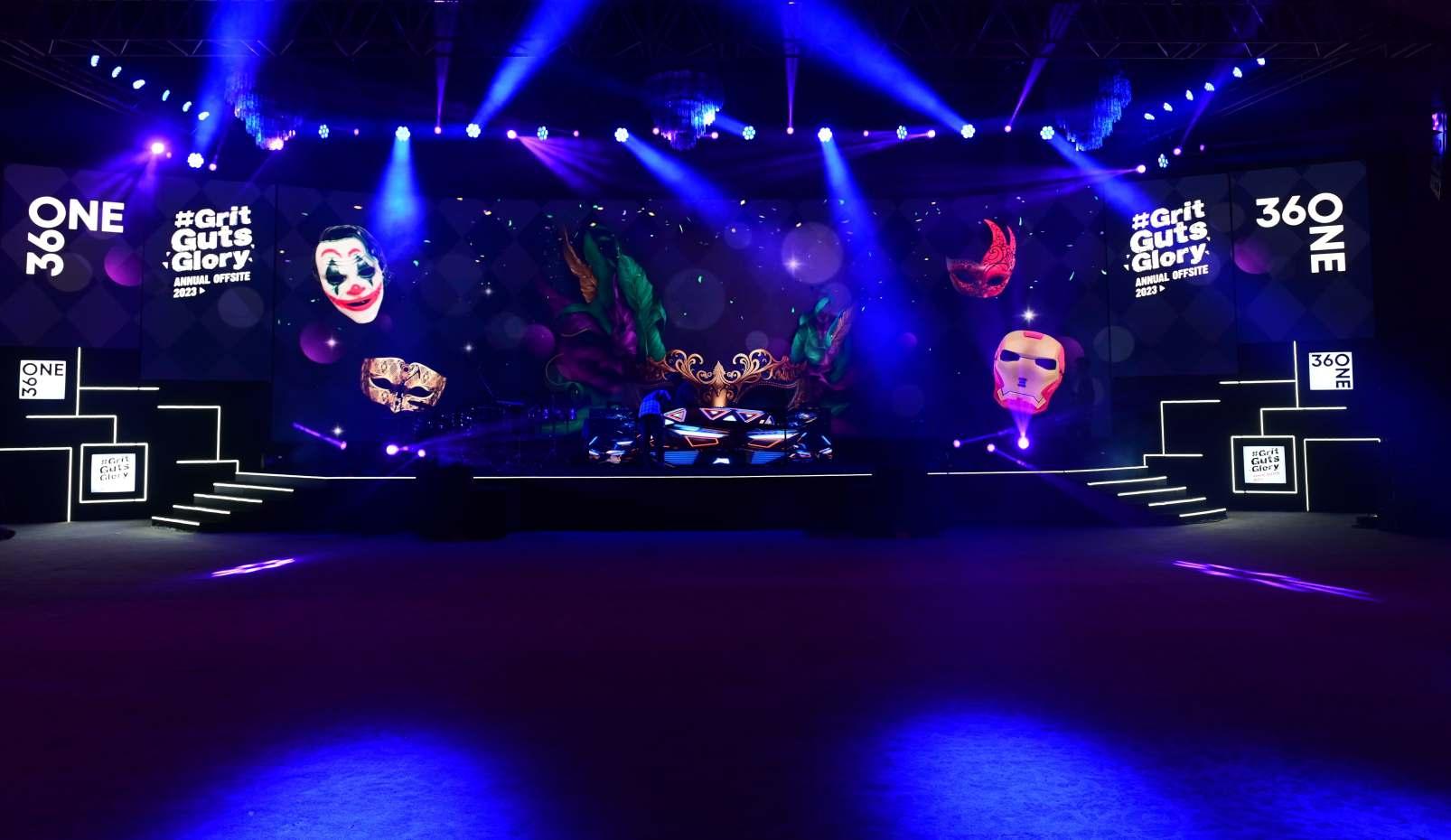


GOA AIMS TO BECOME INDIA'S NEXT INNOVATION HUB WITH AI AND TECH CENTRES
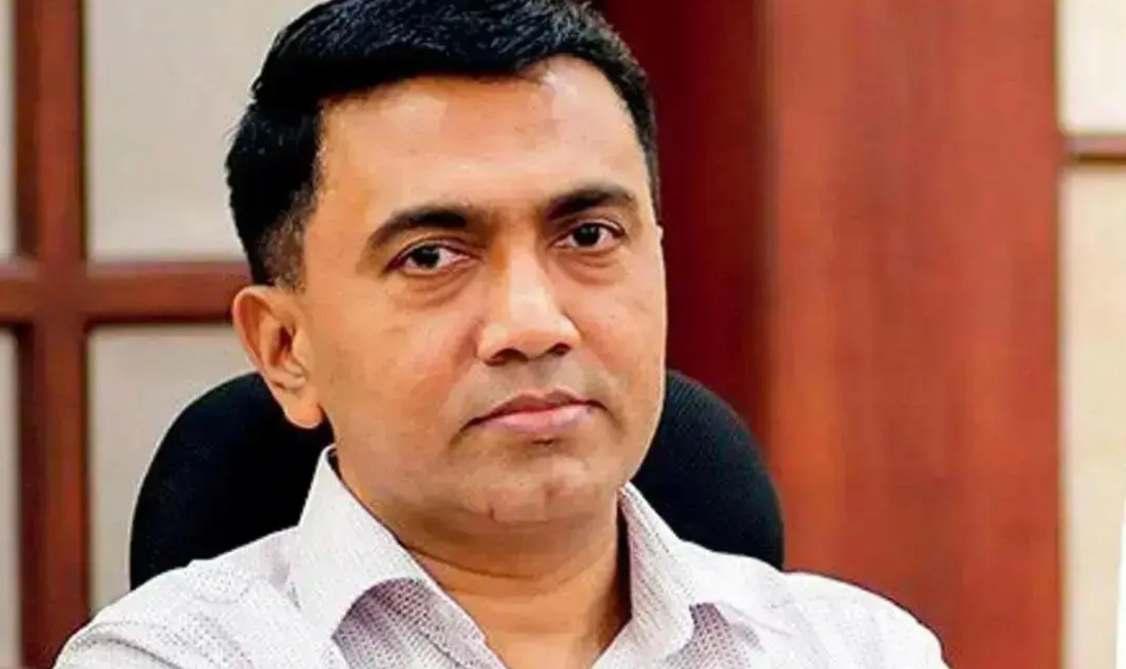
The Government of Goa is embarking on a transformative journey to establish global capability centres and Artificial Intelligence excellence hubs, positioning the coastal state as a premier destination for innovation a n d t e c h n o l o g y - l e d entrepreneurship.
In a strategic move to diversify its traditionally tourism-driven economy, Goa is investing in infrastructure that supports the
growth of deep tech and startups. The proposed global capability centres akin to innovation hubs—will cater to multinational companies seeking research, development, and operations facilities The government's ambition is clear: transition from a leisure hotspot to an innovation
p o w e r h o u s e , l e v e r a g i n g advanced technologies to create s u s t a i n a b l e , h i g h - v a l u e employment.
Meanwhile, the AI excellence hubs will act as central points for fostering Artificial Intelligence skills. Created to offer access to state-of-the-art infrastructure, mentorship, and funding, these hubs will support startups and e m e r g i n g c o m p a n i e s i n developing AI solutions that have p r a c t i c a l , r e a l - w o r l d applications.
Industry leaders have emphasised the importance of fostering a collaborative environment between the government, private enterprises, academia, and startups. Early indicators suggest that this synergy is already in motion, with local universities partnering with tech firms for AI research, and state-backed incubators actively mentoring new ventures in various sectors. Moreover, the government's push to digitise public services and adopt AI-driven solutions internally is expected to serve as a living laboratory for startups. By
offering real-world problems and testbeds, the state hopes to accelerate product development cycles and attract solution-driven entrepreneurs from across the country.
Goa's ambitious plan to set up global capability centres and AI excellence hubs represents a pivotal step in reshaping the s
Traditionally known for its tourism and natural beauty, Goa is now striving to become a serious contender in India's digital economy. By aligning technology with lifestyle, the state hopes to attract startups and multinational companies seeking innovationfriendly environments outside crowded urban centres. If Goa can navigate these challenges effectively, it has the potential to become a national benchmark for innovation-led development in smaller states.
GOA BASED KINECO SIGNS LANDMARK DEAL WITH EUROPEAN AEROSPACE LEADER FACC AG

In a significant development for India's aerospace sector, Austrian aerospace firm FACC AG has signed a seven-year agreement w i t h G o a - b a s e d K i n e c o Aerospace & Defence to supply structural parts for commercial aircraft. This marks the first c o l l a b o r a t i o n b e t w e e n a European aerospace supplier and a G o a n c o m p a n y i n t h e commercial aviation sector. The agreement, announced during the 2025 Paris Air Show, initiates a 10-month phase of
technical and operational coordination between FACC and K i n e c o U p o n s u c c e s s f u l execution, this partnership will integrate Kineco into FACC's g l o b a l s u p p l i e r n e t w o r k , enhancing India's presence in the global aerospace value chain. The decision to partner with Kineco reflects a strategic shift towards globally competitive partners who meet stringent quality and cost benchmarks. FACC's clientele includes industry giants such as Airbus, Boeing,
Bombardier, and Embraer. Kineco, headquartered in Pilerne, Goa, has invested in state-ofthe-art capabilities and worldclass manufacturing practices to align with the evolving needs of Tier-1 companies and global commercial aircraft original equipment manufacturers The parts manufactured at Kineco's facility are expected to be incorporated into aircraft delivered to Indian carriers like Air India and IndiGo, which have collectively placed orders for 1,830 aircraft from Airbus and Boeing.
This landmark partnership between FACC AG and Kineco Aerospace & Defence not only highlights the increasing trust i n t e r n a t i o n a l a e r o s p a c e companies are placing in Indian manufacturers but also serves as a catalyst for further growth in Goa's industrial landscape.
The collaboration is expected to g e n e r a t e e m p l o y m e n t
opportunities in the region, boost local supply chains, and attract further investments in advanced manufacturing technologies Experts believe this collaboration could inspire more European and global aerospace firms to explore p a r t n e r s h i p s w i t h I n d i a n manufacturers, especially in emerging hubs like Goa The state's growing infrastructure, skilled workforce, and proactive government policies make it an attractive destination for hightech industries.
Ultimately, Goa's entry into the global aerospace supply chain showcases how smaller states c a n c a r v e o u t n i c h e s i n sophisticated industries by leveraging talent, technology, and strategic partnerships. This achievement reinforces India's broader vision of becoming a g l o b a l m a n u f a c t u r i n g powerhouse and signals a promising future for Goa's industrial transformation.
GOA'S FESTIVALS AND CONCERTS DRAW INTERNATIONAL CROWDS AND BUSINESS

Goa is shifting its focus from just beach tourism to cultural tourism and concerts to attract more visitors and reduce crowding on its beaches. Once known mainly for its beautiful coastline and beach parties, Goa is now b e c o m i n g a h u b f o r l i v e entertainment and cultural events. This change is part of the Goa Tourism Master Plan 2020, which promotes sustainable and year-round tourism.
Kedar Naik, Director of Tourism in
Goa, said that the state is now a vibrant place for global creativity and cultural activities Major events like the Sunburn Festival, which generates over Rs 250 crore in economic activity, and the Serendipity Arts Festival, attracting over 4,50,000 visitors from around 50 countries, have helped boost tourism. Other important events like the International Film Festival of India (IFFI) and traditional festivals also bring in between 5 to 10 lakh
tourists annually.
Enhanced connectivity is also contributing New international flights from Kuwait, Dubai, and Abu Dhabi, combined with a busy network of domestic airlines, s i m p l i f y a c c e s s t o G o a Infrastructure improvements, including better highways, railways, and bridges, support this increasing tourism.
G o a i s e x p a n d i n g i t s infrastructure with permanent event venues and promoting festivals year-round It already hosts well-known music festivals like the Goa International Jazz Live Festival and the R3set Music Festival, attracting many artists who now see Goa as a second home.
Other states, such as Assam, are mimicking Goa's approach by investing in the concert economy. For instance, Assam aims to host international artist Post Malone t
economic gains from Coldplay's concerts earlier in 2025. T
encouraging private companies to invest in event infrastructure to host international shows. Offering tax benefits and faster approvals makes it easier for businesses to p a r t i c i p a t e , h e l p i n g G o a compete with other popular tourist destinations globally.
As more tourists come to experience Goa's vibrant festivals and rich cultural heritage, the state is set to strengthen its position as a leading destination for cultural and entertainment tourism in India This strategy promises long-term benefits by creating a dynamic tourism e c
businesses, communities, and the overall economy.



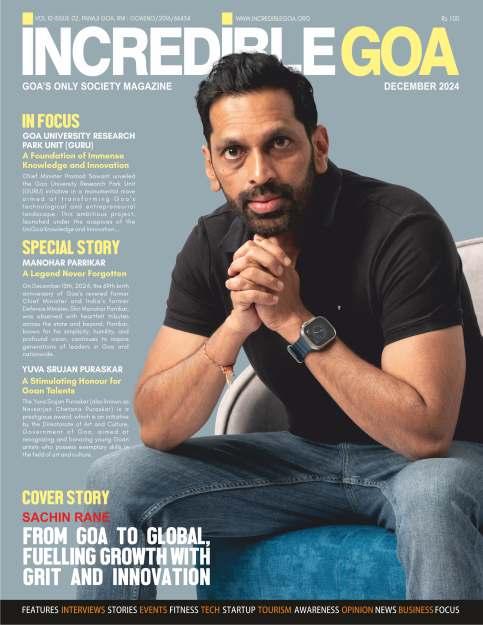

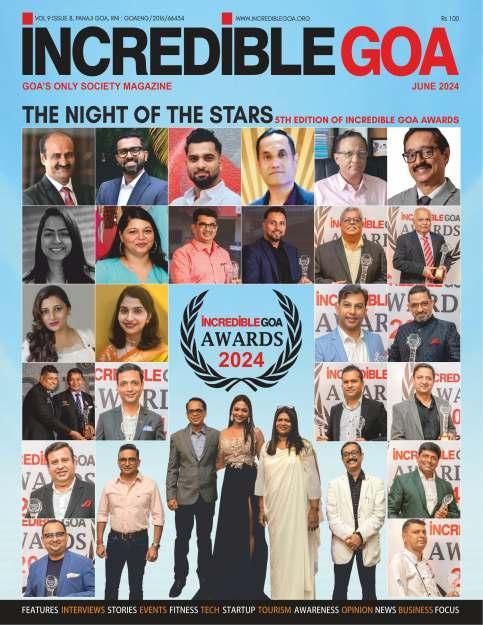

FITNESS

By Norbert D’Souza
HOW TO STRENGTHEN YOUR JOINTS?

Exercise is very important for everyone, but it is especially important for people who are suffering from arthritis. However, if you are afflicted with any form of that disease, running, aerobic dance and most team sports are probably out of your league. But it doesn't mean that you can't be physically active. Here are some exercises that will help you to strengthen your joints.
Regular exercise strengthens your heart and lungs and it can strengthen bones, slowing d o w n t h e p r o c e s s o f osteoporosis. It can help you move easily by keeping your joints, tendons and ligaments more flexible. Can help you lose weight when combined with good eating habits or maintain ideal weight by burning excess calories and promote sense of well being.
Arthritis affects thousands of people each and every year. The term arthritis means "inflammation of a joint “and it actually refers to many conditions that can cause pain in your body's joints. The most common form of arthritis that occurs in older adults is osteoarthritis, w h i c h i s a l s o k n o w n a s t h e "degenerative joint disease."
As a person gets older this type of arthritis may develop simply due to the normal wear and tear of the joints over the years as the body ages. Other factors that may hasten the development of osteoarthritis include being overweight, having a poor posture, or even a previous injury. A wearing out of the cartilage that covers the ends of the bones results in chronic irritation The cartilage becomes soft and wears unevenly. In some circumstances it may wear away completely, exposing the underlying bone. Thickening of the ends of the bone may occur. Usually a person who is suffering from osteoarthritis only has problems in the joints of their hip, knee and spine Sometimes the pain associated with it can be relieved with rest, while other times, especially in the case of more serious symptoms, drugs may be used to reduce the swelling. In addition, exercises can be taught to help strengthen the muscles around the joint to reduce the stress u p o n i t O n l y i n v e r y s e v e r e osteoarthritis cases is surgery necessary to replace or repair the damaged joints.
Exercise is very important for everyone, but it is especially important for people who are suffering from arthritis. However, if you are afflicted
with any form of that disease, running, aerobic dance and most team sports are probably out of your league. But it doesn't mean that you can't be physically active. Here are some exercises that will help you to strengthen your joints:
Ride a bicycle. Unlike walking, running, aerobic dancing and other weight-bearing activities, cycling is gentle on your joints and can be done by people of all ages.
Stretch Often overlooked or just plain neglected, stretching exercises are a vital way to strengthen your joints, keep you limber and feeling good at the same time. I recommend doing at least a half an hour of stretching two or three times a week, but every day is even better, if only for a short period of time.
Many age-related stiffness is simply the result of inactivity.
Climb the stairs. This form of exercise is probably one of the most efficient ways of strengthening the bones, muscles and joints of your lower body. What's more, stairs are everywhere, and they're free You don't need a membership in an expensive health club; the stairs in your home or at the super market will do just fine.
Swimming. Even if you can't swim, you can use the pool for an excellent workout to help strengthen those joints. Remember, if it's hot and humid outside, you surely won't want to exercise But a quick trip to the swimming pool will not only cool you off, it can set you on the road to a healthier lifestyle.
FLEXIBILITY EXERCISES:
Yoga, Tai Chi, and stretching improve range of motion and flexibility, which can prevent injuries and improve joint function.
Most people hate to exercise. They are usually more comfortable sitting in front of the TV instead. But the trick is to make exercise fun, and find one that excites you and that you look forward to doing several times a week. And when you become bored, make slight changes in your routine, keep it exciting. Experiment and find out what works best for you. Once you find that perfect exercise that is just right for you, you won't hesitate to get off the couch and begin a healthier way of life.

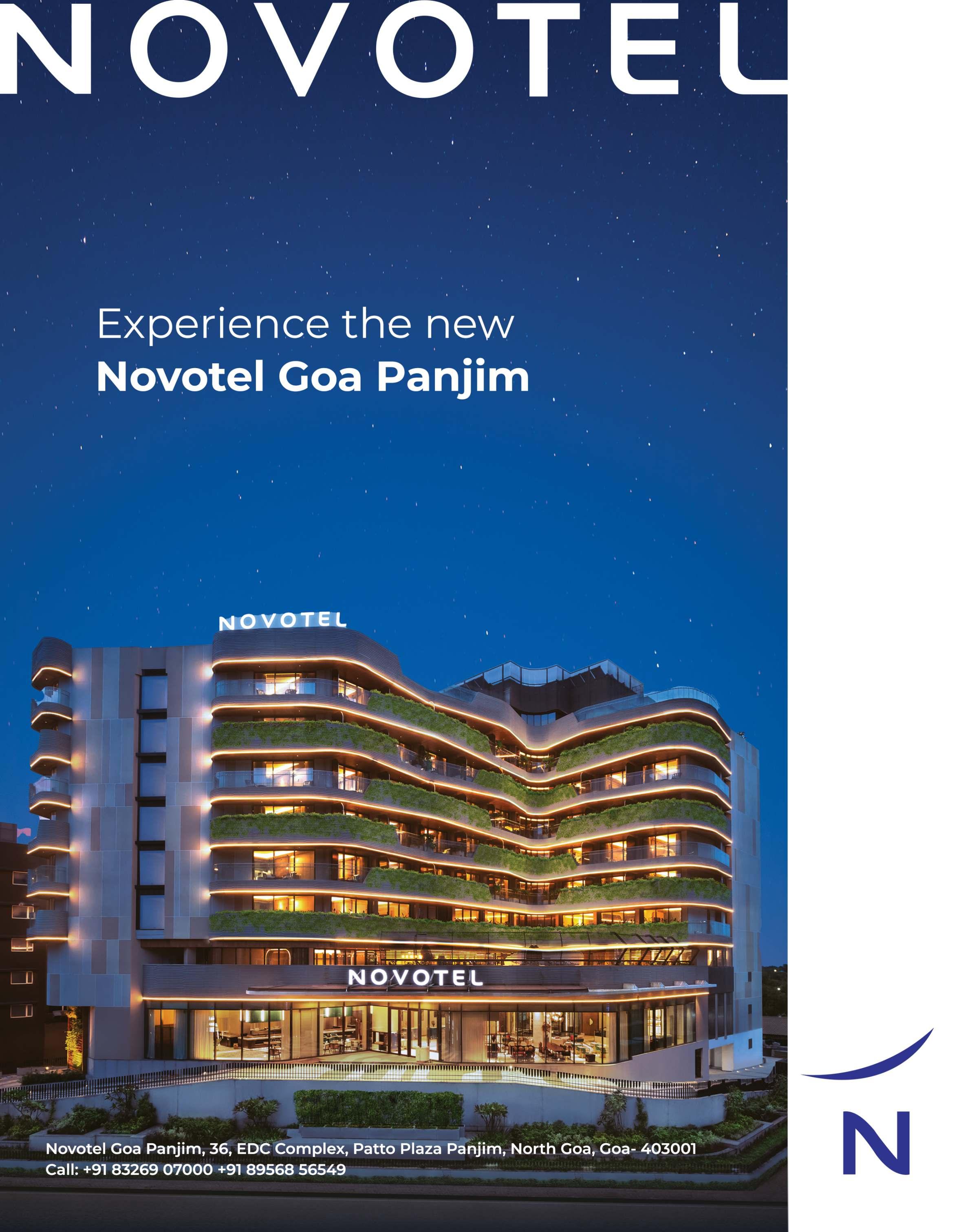

By CAGaurav Kenkre
ADDITIONAL INFORMATION IN ITR

Ÿ Life insurance – Policy number
Ÿ PPF – Account number
Ÿ ELSS – Folio number
3 . S e c t i o n 8 0 D – H e a l t h
Insurance DeductionTo claim a deduction under Section 80D for health insurance premiums, more specific details must now be disclosed to validate the policy and insurer.
Most of the additional information being sought in the Income Tax returns this year, applies to taxpayers who wish to claim the deductions under the Old Regime. The main purpose of asking such information is to thwart that category of taxpayers who have been making bogus deduction claims. With these details, the Income Tax Department would digitally verify the authenticity of the claims.
CA Gaurav Kenkre is a CA in practice for the last 11 years. He is a regular speaker at v a r i o u s p r o f e s s i o n a l organizations, trade bodies, MNCs and Government b o d i e s H e a l s o w r i t e s regularly in local as well as national publications. Besides this he holds various positions in bodies such as ICAI, GCCI, College bodies, Rotary etc.
The Income Tax Return (ITR) filing season for Assessment Year 2025–26 is now underway, although belatedly. The Income Tax Department was slow to release the ITR forms and schema and hence, they have suo moto extended the due date for filing ITRs by non-auditable assessees, to 15th September 2025 It appears that the ITR forms this year have significant changes hence the date has been extended by such a margin Further, whatever forms have already been released, show the same signs.
M o s t o f t h e a d d i t i o n a l information being sought in the Income Tax returns this year, applies to taxpayers who wish to claim the deductions under the Old Regime. The main purpose of asking such information is to thwart that category of taxpayers who have been making bogus deduction claims With these d e t a i l s , t h e I n c o m e Ta x Department would digitally verify the authenticity of the claims.
1. To claim an exemption for House Rent Allowance (HRA) under Section 10(13A), taxpayers must now furnish more detailed information in their income tax returns.
Details required include:
Ÿ Work City: The city where you are employed, which is crucial as HRA exemption limits differ based on whether the city is classified as metro or nonmetro.
Ÿ Actual HRA Received: The
total HRA amount received from your employer during the financial year.
Ÿ Rent Paid: The total rent actually paid during the year f o r r e s i d e n t i a l accommodation. This directly affects the HRA exemption calculation.
Ÿ Basic Salary plus Dearness Allowance (DA): The sum of your basic salary and DA forms the basis for computing the exemption, as it is capped at a percentage of this amount.
Ÿ M e t r o / N o n - M e t r o Classification: You must clearly indicate whether your work city falls under the “metro” (e.g., Delhi, Mumbai, Chennai, Kolkata) or “ nonmetro” category. Metro city residents are eligible for up to 5 0 % o f b a s i c + DA a s exemption, while non-metro residents can claim up to 40%.
2. Section 80C Deduction – New Disclosure Requirements For claiming deductions under Section 80C which includes investments like PPF, EPF, life insurance premiums, ELSS, home loan principal repayment, tuition fees, etc taxpayers are now required to provide identifiable details for each item. This change aims to enable direct verification of the investments claimed.
P o l i c y o r D o c u m e n t Identification Number: For every investment or policy under 80C, you must provide a unique identifier. For example:
Ÿ Name of Insurer: The full legal name of the health insurance company (e g , HDFC ERGO, Star Health, ICICI Lombard).
Ÿ Policy Number or Reference Number: The unique identifier for the policy, used for verification.
4. Section 80E – Education Loan Interest To avail the deduction for interest on education loans under Section 80E, taxpayers must provide comprehensive loan d e t a i l s . T h i s e n s u r e s t h e d e d u c t i o n p e r t a i n s t o a l e g i
recognized lender.
Ÿ Name of the Lender/Bank: The full name of the financial institution granting the loan.
Ÿ Loan Account Number: The specific account number a s s o c i a t e d w i t h t h e education loan.
Ÿ Sanction Date: The date on which the loan was approved and disbursed.
Ÿ Original Loan Amount: The initial principal sanctioned.
Ÿ Outstanding Balance as of M a r c h 3 1 : T h e u n p a i d principal amount at the end of the financial year.
The above are some of the common deductions claimed by taxpayers under the old regime, a n d h o w t h e I n c o m e Ta x Department is trying to tighten the screws on those taxpayers who were claiming bogus deductions Genuine taxpayers have nothing to worry but they will have to start collecting above additional information so that they can file a complete and timely income tax return.
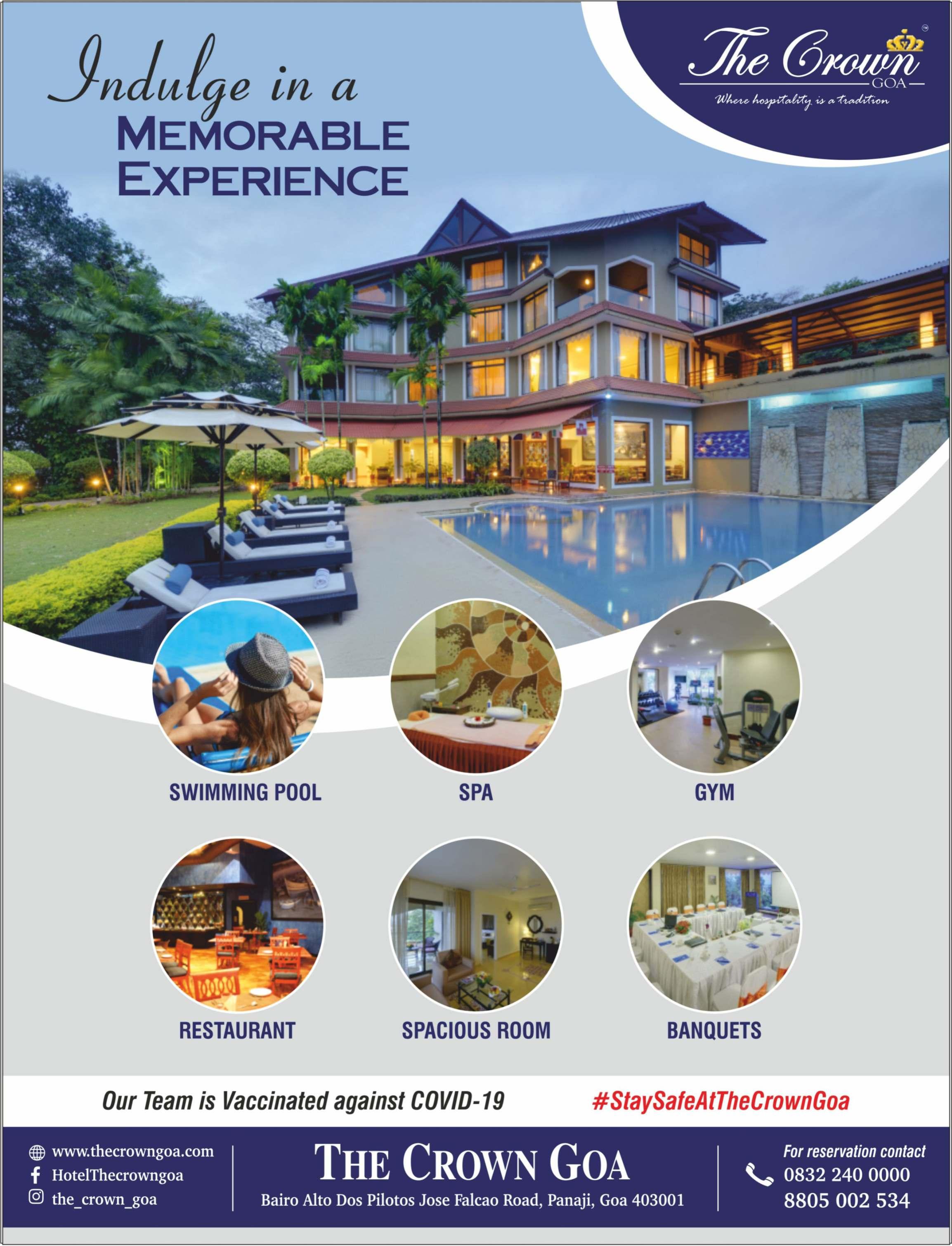

By Prashant Kalra
LIFE’S A BEACH… OR IS IT?
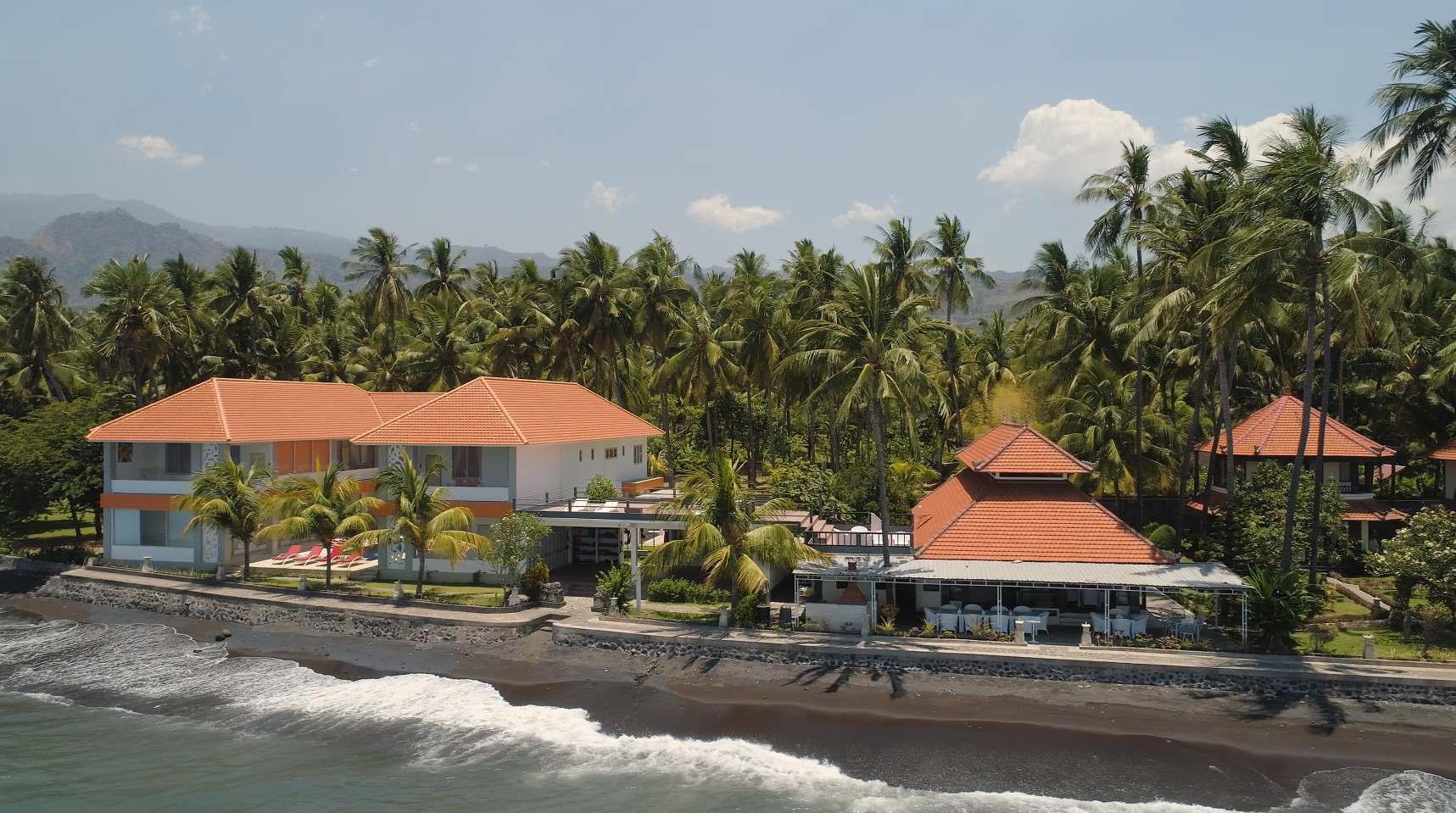
Is it time for Goa’s eastern belt to enjoy its time in the sun? Are the beach belts of Goa overly commercialized and no longer attractive to homebuyers? Let’s look into this by comparing what a buyer gets for the same price, both west of the highway and east of the highway.
Is it time for Goa’s eastern belt to enjoy its time in the sun? Are the beach belts of Goa overly commercialized and no longer attractive to homebuyers? Let’s look into this by comparing what a buyer gets for the same price, both west of the highway and east of the highway.
THE COMPARISON
For clarity, we’re going to take a horizontal stretch of Goa and study what buyers can get for a Rs 5-8 crore price tag We’ll compare comparative value and appeal.
ON THE WESTERN FRONT
To the west, for this exercise, we’re taking the popular beach belt of Anjuna/Vagator. Here, for a sum of Rs. 5-8 Cr, you can expect to buy an entry level luxury villa The plot size would be roughly 200-250 sqmt, the super built up area would be 30004000 sqft. You would also expect a sizeable number of villas in the project with each one being very close to the next.
rentals in terms of number nights a year.
However given the investment cost being higher than 2021, the supply of rental villas being higher than 2021 and the overall operation costs being a factor, the overall return on investment for such villas is a question mark.
FEAST IN THE EAST?
To the east, we have the villages of Moira, Nachinola, Uccasaim and Aldona. These villages have recently gained huge traction from both developers and home buyers On average, in these locations, for Rs. 5-8 Cr, you can expect to buy a decent sized villa with a plot size of 350-500 sqmt with a super built up area of 4000-5000 sqft. You could also expect projects to have lesser number of villas and for the locations to be greener and more peaceful overall.
geared towards long term rentals is the fact that the revenue is stable, operating costs are almost zero and competition has a very limited impact. The added advantage is that since entry p r i c e a n d o v e r a l l v a l u e proposition tends to be more attractive, the scope for capital appreciation goes up. Another factor working in favour of the east is that land prices, w h i l e h a v i n g g o n e u p exponentially over the past few years, are still almost half of prices in the corresponding western belt. This allows builders to offer better value to buyers which has led to the eastern belt being more attractive for value hunters.
CONCLUSION
Prashant is the founder of TPB, a boutique real estate consultancy in Goa, focussing on ultra luxury homes He moved to Goa from Gurgaon in 2019 after his daughter developed breathing issues.
While this may not sound very appealing, these villas are primarily bought for letting out on short term rental basis. Such villas are rarely ever used by the owners. Given the proximity to the beach and popular tourism hubs, t h e s e h o m e s t e n d t o d o reasonable well for short term
As appealing as this may sound to a self use homebuyer, these villas tend to be less popular with tourists looking to rent holiday homes for 2-3 nights Such tourists usually prefer being closer to the beaches which means such villas don’t always do well on short term rentals. However, these locations tend to get a lot of self use buyers as well as long term rental tenants.
The advantage of owning a home
Goa’s real estate story has never stopped evolving. Every month, there are changes in trends, challenges and sales that have rippling effects across the sector. The growth of the eastern belt as an investment destination for those who are not attached to the idea of short term rentals has led to a boom In some eastern locations, land prices have gone up 4x in 3 years. While this presents its own set of challenges, it has confirmed that the eastern belt of Goa is definitely in the limelight.

HEALTH

DEBUNKING MYTHS ABOUT SMARTPHONES AND BRAIN TUMOURS

It is understandable that evidence of even a small increase in cancer risk from cell phones would be a cause of public concern given the way we are using them currently.All these devices are held close to the head and there issome evidence that ionizing radiation could cause certain type of cancers.
With advances in all fields pertaining to life and lifestyle, the use and sometimes (?) overuse of technology is a given. The world currently has become dependent on the mobile devices- laptops, mobiles, smartwatches- for all their daily activities. One of the chief concerns raised, especially, by parents is the risk of brain tumours due to cell phone usage. It is understandable that evidence of even a small increase in cancer risk from cell phones would be a cause of public concern given the w a y w e a r e u s i n g t h e m currently All these devices are held close to the head and there issome evidence that ionizing radiation could cause certain type of cancers.
The other recognized effect of such radiation is heating of the area where the cell phones are held. However, this heating is not sufficient to significantly affect our core temperatures. However, a few other things have to be kept in mind. As the technology behind the cell phone (G- 3G/4G), the overall usage and dependence changes, the data obtained through these studies may change in the future. Also, one has to keep in mind that the nervous system of children is more susceptible and vulnerable to all factors that may cause cancer.
driving
F Avoid making calls when the signal is weak
F Use speaker mode and head phones to increase the distance between the head and device
F W i r e d e a r p h o n e s are generally considered a healthier option than wireless ones, as they emit no radiation.
P l e a s e r e m e m b e r t h a t technology, like food, should be consumed in moderation for a happier and healthier life.
Dr Omkar N Churi, DNB Neurosurgery, Fellowships in Epilepsy and Spine (UK).
F e l l o w s h i p i n Va s c u l a r N e u r o s u r g e r y ( J a p a n ) .
Multiple awards for best p a p e r i n n a t i o n a l a n d international conferences
Multiple publications in journals.
However, the current evidence and data from multiple studies suggests that the cell phone use has NOT increased the incidence of brain or other cancers. It is to be noted that all the cell phones and networks operate on the radiofrequency range which falls in the 'low frequency, low e n e r g y ' e n d o f t h e electromagnetic wave spectrum.
T h e o t h e r s o u r c e s o f radiofrequency radiation in our h o m e s a r e r a d i o s , o v e n s , televisions and computers.
The other documented health effects from cell phone use are distracted driving and vehicle accidents In 2024, Oxford University Press chose “Brain Rot” as their Word of the Year. This has been attributed to consumption of low-quality content online, mindless scrolling and the risk of subsequent intellectual decline. Things we can do to prevent all this
F Reduce amount of time spent using the cell phone
F Avoid unnecessary calls, text rather than talk
F AVOID texting or device-tothe-head talking during








GOA’S PREMIER NEWS MEDIA
WEBSITE
SINCE 2014














